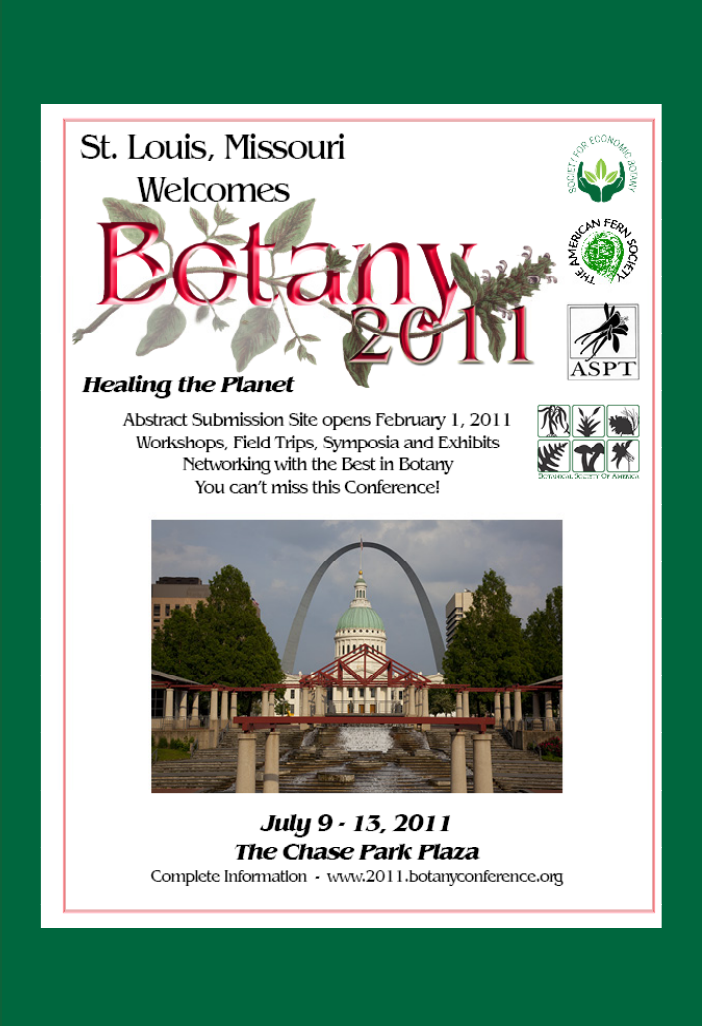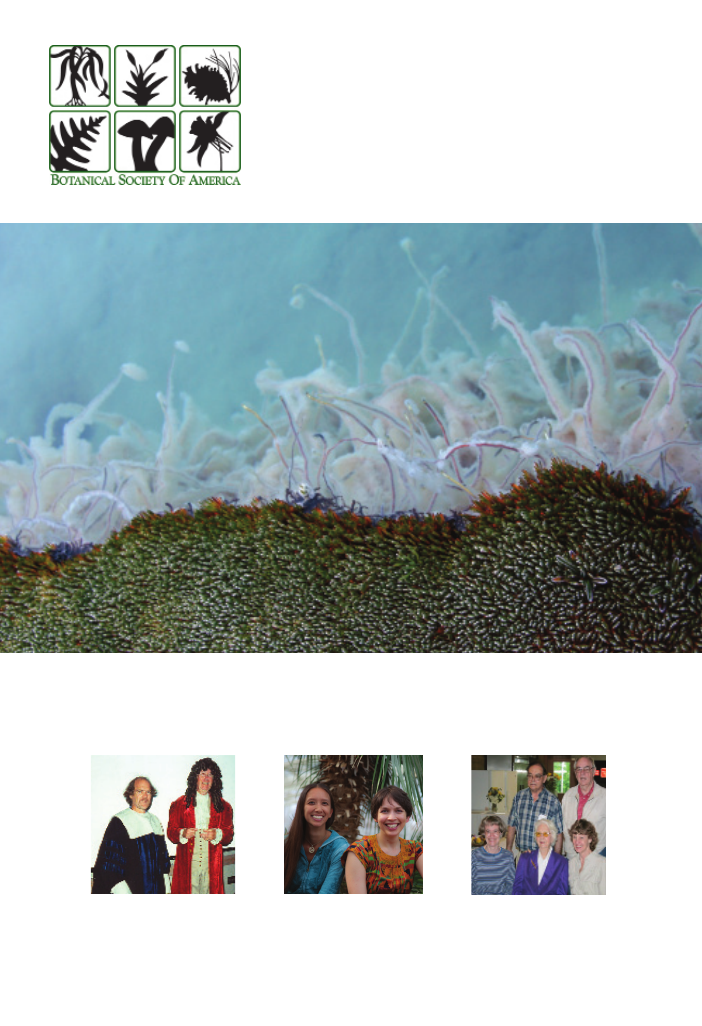
P
LANT
S
CIENCE
Bulletin
Spring 2011 Volume 57 Number 1
Student’s respond to Federal
Policymakers go to page 2
Dr. Elsie Quarterman celebrates
her 100th birthday see page 11
Oldenberg &Van Leeuwenhoek at
the 1994 BSA annual meeting.
Read more on page15
In This Issue..............
A crystal pond surrounded by cushion plants (Distichia muscoides Nees & Meyen) provides the playground for Nature to play
with shapes and colors beyond the imagination. See Inside back cover for the scientific description.

From the Editor
Spring 2011 Volume 57 Number 1
PLANT SCIENCE
BULLETIN
Editorial Committee
Volume 57
Jenny Archibald
(2011)
Department of Ecology
& Evolutionary Biology
The University of Kansas
Lawrence, Kansas 66045
jkarch@ku.edu
Root Gorelick
(2012)
Department of Biology &
School of Mathematics &
Statistics
Carleton University
Ottawa, Ontario
Canada, K1H 5N1
Root_Gorelick@carleton.ca
Elizabeth Schussler
(2013)
Department of Ecology &
Evolutionary Biology
University of Tennessee
Knoxville, TN 37996-1610
eschussl@utk.edu
Christopher Martine
Department of Biology
State University of New York
at Plattsburgh
Plattsburgh, NY 12901-2681
martinct@plattsburgh.edu
T
he Plant Science Bulletin (PSB) is starting
the year with a new look and high expec-
tations for raising botanical awareness in the
public consciousness. For the past few years
several of us have been representing the Society
on the advisory board of the Botanical Capac-
ity Assessment Project. Through that involve-
ment it became clear that professional botanists
in all sectors, including academe, must become
more proactive in promoting our discipline to
the general public and to policy makers in the
government and federal agencies. In last year’s
issues of PSB you may have noticed letters from
Past-President Holsinger, sent on behalf of the
Society, to key agencies and administrators to
provide input on legislation and spending. In
this issue I’m pleased to recognize the initiative
of our youngest members, whose “An open letter
to federal policymakers from science students”
is now being promoted by AIBS as a vehicle for
all science students to influence policy makers.
Forward the link to your students and encour-
age them to contribute - - then think about ways
you, and the Society, can become more effective
lobbyists for botany.
Also in this issue is a tribute to the late Profes-
sor Larry Crockett, who used history and art to
great effect in teaching botany. He opened my
eyes to the botanical contributions of Antoni van
Leeuwenhoek, which are invariably neglected in
textbooks. I hope you will find this brief review
of the great microscopist’s botanical discoveries
to be enlightening and useful in your teaching.
-Marsh
Carolyn M. Wetzel
Department of Biological
Sciences &Biochemistry
Program
Smith College
Northampton, MA 01063
Tel. 413/585-3687
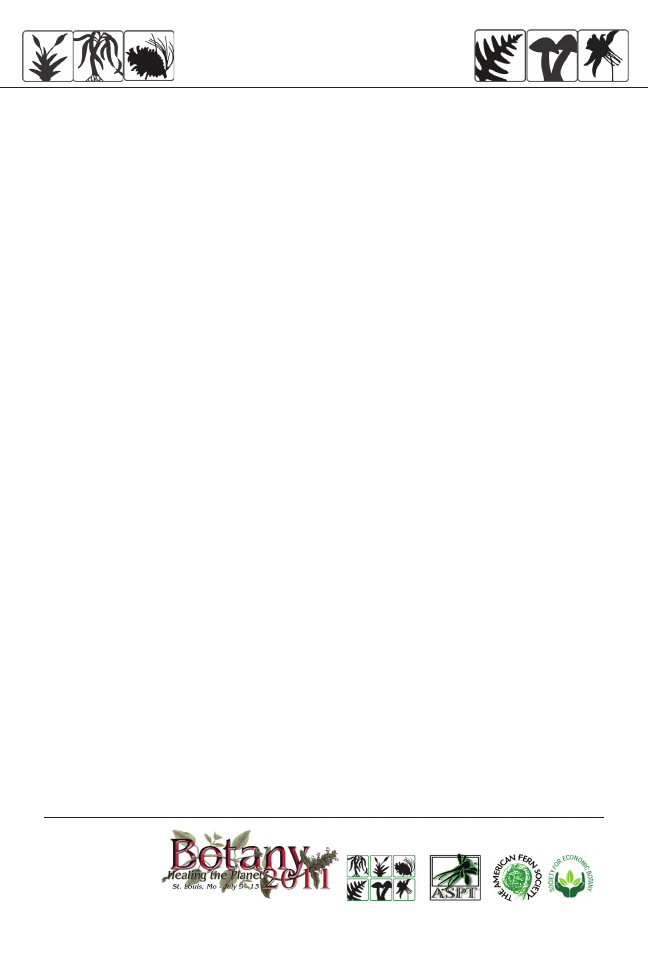
1
Table of Contents
Society News ............................................................................................. 2
An Open Letter to Federal Policymakers from Science Students ................................2
Open Science Network .................................................................................................3
Science Prize for Inquiry-Based Instruction .................................................................4
Historical Section Announcement for Botany 2011 .....................................................4
BSA Science Education News & Notes ..................................................... 5
Editor’s Choice Reviews ............................................................................ 7
In Memoriam ............................................................................................. 8
Frederick W. Case Jr. (1927-2011) ............................................................................8
William Julian Koch (1925 – 2009) ............................................................................8
Charles H. Uhl (1918 – 2010) ...................................................................................10
Personalia ................................................................................................. 11
Dr. Elsie Quarterman .................................................................................................. 11
Opportunities ............................................................................................ 12
microMORPH Grants .................................................................................................12
2011 Seminars at the Humboldt Institute on the Coast of Maine! ............................12
MSc Degree/Postgraduate Diploma in the Biodiversity and Taxonomy of Plants .....13
Reports and Reviews ................................................................................ 15
The Botanical Investigations of Antoni van Leeuwenhoek ........................................15
Books Reviewed ...................................................................................... 26
Ecological ...................................................................................................................26
Economic Botany .......................................................................................................29
Historical ....................................................................................................................28
Phycological ...............................................................................................................32
Systematic ...................................................................................................................32
Books Received ....................................................................................... 40
www.botanyconference.org
Register NOW....

2
communicate the change that students want to see:
that by prioritizing science education and research
opportunity, the US can be a leader in innovation.
Statistics on the current state of education in this
country are evidence that this leadership position is
not guaranteed in the future of this country.
I want to acknowledge the leadership and
dedication of the team of students that came
together to take action. You have inspired me
about what is possible to accomplish. You have
also established an example, that future students
can follow, about how students can use the BSA
community to help bring their ideas to fruition.
Please help the number of signatures on the
petition grow by signing and distributing the letter
available through this link:
http://www.aibs.org/public-policy/science_
students_letter.html
Anecdotes:
When one of the faculty at UGA mass e-mailed
the YouCut video, which suggested that citizens re-
review NSF projects as a way to “cut government
waste,” some of our lab members had a brief
discussion that basically amounted to our all shaking
our heads and saying, “somebody oughtta....” After
silence from other quarters, I realized “somebody”
might have to start with me. I approached the
BSA student section with the idea of writing an
open letter and was grateful to find others who
had similar concerns. It’s been enlightening to
work with such a thoughtful group of scientists
who are passionate about science policy, and who
can transform ideas into wording that is concise,
accessible, and politically even-handed.
--from Lindsay Tuominen
In the age of information, it is often difficult for
issues to seem immediate or engaging. But when a
fellow student sent an e-mail out to the BSA student
listserv about the proposed “YouCut” NSF budget
cuts, I felt like we had to do something, not just
as students interested in our own funding but as
members of the larger scientific community. Others
felt similarly, and soon this issue had connected
students from all across the United States, joining
us together in a discussion of what should be done.
Though we are students from various fields and
Society News
On “An open letter to federal
policymakers from science
students”
By Rachel Meyer, student representative of the BSA
I have always been impressed with the energy of
the students in the Botanical Society of America.
Perhaps what makes this society so special is that
the student body is very dedicated to help shape
the BSA, and likewise, the BSA is always looking
for ways to get students involved and to give them
a voice. The result is a community network that
transitions very quickly from idea to product.
The power of this network is beautifully
exemplified by the open letter from students
carrying the message that the US needs not only
to continue, but to strengthen, their investment in
scientific research and education. It started with
one student posting a message to the new student
listserv. It was about the need to respond to the
YouCut program, which targeted the National
Science Foundation’s system of funding research
grants and choice of research projects that deserve
this funding. Several students responded, formed
a group, and wrote a detailed letter on this issue as
a response.
That letter can be viewed at this link:
https://botany.org/BSA_Students-NSF-12162010.pdf
When the BSA office received news of this
student initiative, they immediately were looking
for ways to maximize the potential impact of the
letter. They also wanted to seize the opportunity
for students to learn about how our government
works. When large groups of people come together
with a message to their representatives, they can be
influential. Bill Dahl put me in touch with Robert
Gropp from the American Institute of Biological
Sciences. We immediately began brainstorming
ways the letter could be signed by thousands of
students across the country and sent to potentially
hundreds of people in politics.
Working with AIBS and the original group of
students who wrote the letter, we put together the
petition that is now being circulated among student
members of dozens of scientific societies. We are
acquiring a large number of signatures (in the first
week we had already gained 400). As the number
of signatures grows, we can use the petition to

3
Plant Science Bulletin 57(1) 2011
backgrounds, we collaborated together to formulate
a nonpartisan response to this attack on the
scientific community and the progress of our nation.
--from Natalie Ma
When I saw the YouCut website, my first
inclination was to jump on Facebook and post my
distaste for the measure. When the opportunity
came to be a part of something larger than a
Facebook rant, I was extremely excited. Working
with a group of young scientists who harbor a
dedication to the future of scientific research
was an amazing experience that I hope to repeat.
Misinformation is a constant phenomenon in the
world today and it makes me feel accomplished
to have been a part of a movement that seeks to
fight misunderstanding. My fellow BSA Student
Action Panel members are amazing and show a
true understanding of issues affecting students,
researchers and our scientific culture. I am very
grateful to them and to BSA for being so supportive
of students seeking to make a difference.
--from Michael McKain
Although I was unable to participate as much in
the earlier part of this process, I was truly impressed
by the way this group of students came together to
take action on such an important issue. Later on I
joined their efforts in editing the letter and getting
it out to students across the country. Using a list of
scientific societies compiled by the BSA student
group, I contacted science policy officers from 21
societies asking them to forward our open letter
to their own student membership. Several of them
replied immediately saying they were forwarding
the message and thanking BSA students for their
leadership and efforts. One society’s president
had already sent the action link to their students
before we even contacted them! Another society
representative thanked us and shared some of their
own activism efforts with us, which we will pass
onto BSA students. It is a great feeling to see our
message being spread across varying disciplines,
encouraging more interactions between us, and to
see that science students across America can come
together in support of political activism that will
benefit our (and future) generations of scientists,
and our country as a whole. I’m honored to be a
part of this terrific group of BSA students who
started it all.
--Marian Chau, student representative of the BSA
Open Science Network
The Open Science Network (OSN) is a National
Science Foundation funded project, coordinated
by the Botanical Research Institute at Texas. OSN
has been leading pioneering work to promote
worldwide collaboration between ethnobiologists
through the continual exchange and enrichment of
educational techniques, materials, and experiences.
This Network champions open educational
resources and uses the latest web technologies to
encourage sharing, generation, and management of
educational tools and curriculum for the traditional
and non-traditional classroom. Ethnobiological
teaching resources have been made openly
available by researchers and educators based at the
University of Hawai’i at Manoa, Frostburg State
University, University of South Carolina, University
of Arkansas for Medical Sciences, and University
of Kent among others. Everyone is encouraged to
visit the homepage
1
, to explore the modules and
curriculum posted, as well as contribute resources
of their own.
We will be hosting an educational colloquia
titled Sharing Our Ethnobotany Curriculum:
the Open Science Approach at the 2011 societal
meetings of the Society for Economic Botany
and Botanical Society of America in St. Louis,
Missouri. Presentations will emphasize the
importance of sharing information and resources
among colleagues; demonstrate the need for peer
and student assessments of curricula in order to
maintain fresh and creative ideas in the field; and
touch on how the creation of open technology has
allowed the spread of ideas to the far corners of
the globe. Participants will be introduced to the
web-based portal and instructed how to use and
contribute to its curriculum resources.
OSN has several travel awards available for any
interested educators, students and researchers
that would like to attend and participate in OSN’s
2011 annual meeting. The deadline for these travel
awards is February 22
nd
. For more information
regarding these awards or the Network, please visit
us at our WiserEarth page
2
.
Keri Barfield (kbarfield@brit.org) &
Sofia Vougioukalou (S.A.Vougioukalou@kent.
ac.uk)
Links to websites:
Homepage- www.opensciencenetwork.net
WiserEarth- http://www.wiserearth.org/group/
opensci_ethnobiology

4
Plant Science Bulletin 57(1) 2011
Science Prize for
Inquiry-Based Instruction
Have you ever actively participated in a science
lab that left a lasting impact on you? Have you ever
taught an interactive science lab and watched as
students lit up with understanding? Science would
like to recognize efforts such as these with the
Science Prize for Inquiry-Based Instruction, which
has been established to encourage innovation and
excellence in education by recognizing outstanding,
inquiry-based science education modules. The
prize is open to any module where students become
invested in exploring questions through activities
that are at least partially of their own design. Rather
than a typical laboratory exercise that begins with
an explanation and results in one correct answer, an
inquiry-based lesson might begin with a scenario
or question and then require students to propose
possible solutions and design some of their own
experiments.
Winners will be selected by the editors of
Science with the assistance of a judging panel
composed of teachers and researchers in the
relevant science fields. Individuals responsible
for the development of the winning resources will
be invited to write a short essay that describes the
resource for publication in Science in 2012. We
encourage all members of the scientific community
to explore their classrooms, departments, colleges,
and universities for nominations in order for the
Science Prize for Inquiry-Based Instruction to truly
represent the best in science education.
To read the accompanying Editorial please visit
http://www.sciencemag.org/content/331/6013/10.
full
For more information and to download
applications please visit http://scim.ag/inquiryprize
Please contact Dr. Melissa McCartney at
mmccartn@aaas.org with any questions.
Melissa McCartney, PhD, Editorial Fellow, Sci-
ence Editorial, 202-285-0300
SCIENCE: www.sciencemag.org
SPORE: www.sciencemag.org/special/spore/
AAAS- Advancing science, Serving society
Historical Section
Announcement for
BOTANY 2011
At Botany 2011 in St. Louis, Missouri this
summer, the BSA Historical Section and co-
sponsoring sections will present a symposium
featuring area botanists. Our decision was based
on the positive feedback we received from similar
symposia organized by the Historical Section
in Chicago, at Botany 2007 and in Rhode Island
for Botany 2010. We invite you to attend our
symposium (see below) and join the exciting field
trip on a behind the scenes look at the extensive
library and herbarium collections at the Missouri
Botanical Garden.
HISTORY OF BOTANY: THE MISSOURI
CONNECTION
Joint symposium with the Historical,
Developmental and Structural, Ecology, Economic
Botany, Paleobotanical Southeastern and
Systematics Sections.
Nuala Caomhanach - “Thomas Nuttall and 19th
Century Botany: The St. Louis Connection”
Michael Long - “George Engelmann’s Fortunate
Connections
Deborah Q. Lewis and Lynn G. Clark - “A.S.
Hitchcock”
Kim Kleinman - “Edgar Anderson, The Missouri
Botanical Garden, & the Rise of Biosystematics”
Betty Smocovitis - “Joseph Ewan and the
Cinchona Missions in Latin America, 1942-1945”
Dennis Stevenson - “William J. Robbins: The
Missouri Years”
Edward Coe - “Lewis J. Stadler: The Nature of
the Gene, and a Clue to DNA”
Lee B. Kass - “Barbara McClintock at the
University of Missouri (1936-1942): The Road to
Transposition”
Following the symposium there will be a field
trip to the Missouri Botanical Garden entitled
“Exploring George Engelmann’s Legacy: The
Missouri Botanical Garden Library and Herbarium”
The Historical Section encourages paper/poster
session contributors. Each year the Emanuel
D. Rudolph award is given for the best student
presentation on an historical subject; this is a cash
award with a complementary banquet ticket.
For additional information please contact the
Symposium Committee:
Marissa C. J. Grant, mgrant39493@lakeland.cc.il.us
or Lee B. Kass, lbk7@cornell.edu

5
PlantingScience
Presentations and Meetings
January 14, 2011. NIBI, The Netherlands
Edith Jonkers, leading the independent Dutch
PlantingScience counterpart, will describe
PlantingScience to Dutch biology teachers.
January 19-22, 2011. Minneapolis, MN:
Association for Science Teacher Education
PlantingScience Co-PI Carol Stuessy and her
graduate students from Texas A&M University
present two sessions “Where the Rubber
Meets the Road in Authentic Science Learning
Contexts: Professional Learning to Classroom
Implementation” and “Applying the Online
Elements of Inquiry Checklist.”
February 3, 2011. Washington, DC: DC
Teachers Night
Katie Engen, ASPB Education Foundation, will
have a hands-on booth to share ASPB activities
and information about the PlantingScience Spring
Online Session and Summer Institute for Teachers.
March 8-9, 2011. Berkeley, CA: Cyberlearning
Tools for STEM Education (CyTSE) Conference
Claire Hemingway will have hands-on
demonstration session at this NSF-sponsored
meeting on K-12 STEM cyberlearning tools.
March 10-13, 2011. San Francisco, CA: NSTA
Conference
Visit us at the booth or attend the March 11 2-3
pm session on “Using Dialogue and Art to Enhance
Science Inquiry and Make Student Thinking
Visible” with PlantingScience teachers Carol
Packard and Allison Landry and botanist/botanical
illustrator Jeanne Debons.
Do you have news or activities you’d like to share
with the PlantingScience community? Please let us
know!
BSA Science Education
News & Notes
BSA Science Education News and Notes is a quarterly update about the BSA’s education efforts and the
broader education scene. We invite you to submit news items or ideas for future features. Contact: Claire
Hemingway, BSA Education Director, at chemingway@botany.org or Marshall Sundberg, PSB Editor, at
psb@botany.org.
PlantingScience
BSA-led student research and
science mentoring program
PlantingScience Spring
2011 Session and Program
Happenings.
January is National Mentoring Month http://
www.nationalmentoringmonth.org/ . Celebrate
by committing to mentor middle school or high
school teams as they conduct plant inquiries in the
Spring 2011 Session. It will run 14 Feb. to 15 Apr.
2011). Last fall brought together 177 scientists,
289 student teams, and 30 teachers to collaborate
online. We anticipate another exciting session this
spring. New this spring will be an international
collaboration between Florida and Dutch schools.
Inquiry teaching and learning in school
settings often presents significant challenges, but
PlantingScience teachers are seeking ways to enrich
the experience. Do you wonder what your volunteer
service as an online mentor offers? Participating
teachers share the value of your collaborations with
classrooms in these quotes:
“I am a much better teacher because of this
program...it let my kids enter the classroom as
working lab technicians instead of students ...they
came into class ready to go, prepared to do science.”
“At every opportunity, all involved kept reminding
my students of the process that real science requires.
This helped me to convince my students that they are
really doing science - not just play acting until some
future date.”
“While I sometimes get frustrated with the level of
effort applied by my students I believe that the end
result is worth all the drama. I had several questions
this year that came very close to my goal of valid
scientific inquiry.”

6
Plant Science Bulletin 57(1) 2011
PlantingScience Summer
Institute for Teachers
June 23-30, 2011. Held at Texas
A&M University, College
Station, TX.
High school and middle school teachers, we
invite you to join botanists Marsh Sundberg
and Larry Griffing and teachers from across the
country to explore plant investigations and inquiry
learning in community. This summer we will focus
on plant physiology and Arabidopsis genetics, and
you’ll have the opportunity to develop a plan to
take any of new or existing inquiry modules to your
classroom. The Institute also offers opportunities
to immerse in the inquiry experience, engage in the
online platform, and share strategies for supporting
team inquiries. Stipends, housing and travel
allowances provided.
Apply online by April 4, 2011. See www.
PlantingScience.org to download a brochure.
http://www.plantingscience.org/institute-
application.html
Science Education
Bits and Bobs
Mixed PISA Results, Scores Improve but High
Achievers Still Scarce in Science — The December
2010 release the most recent data on the Program
for International Student Assessment (PISA)
reiterate the lower than top performance of U.S.
students compared to other nations in reading,
math, and science literacy. Compared to the last
round of PISA data collected in 2006, US students’
science scores for 15-year-olds improved, and the
U.S. average score in science literacy in 2009 is now
not measurably different from the average for other
OECD countries. Countries with higher average
science scores than the US include: Finland, Japan,
Korea, New Zealand, Canada, Estonia, Australia,
the Netherlands, Germany, Switzerland, the
United Kingdom, and Slovenia. Proficiency in
science literacy is described by PISA according to
levels ranging from 1 to the most advanced of 6.
29% of US students scored at a level 4 in science
proficiency.
PISA Report
http://nces.ed.gov/pubsearch/pubsinfo.
asp?pubid=2011004
8-10 year-old U.K. Students Publish Bee Visual
Perception Research — What can you do with
curiosity about the natural world, access to
science experts, and a few simple rules to a game?
Publish real science for starters. Students in the
Blackawton Primary School, their headteacher, and
a vision researcher from University College London
collaborated on a study of bee vision and behavior.
While the researcher trained the bees in the study,
the students asked the key questions, hypothesized
possible answers, designed experiment features,
analyzed the data and contributed to the manuscript
by drawing the figures and describing their key
findings. This novel publication in “kids speak”
speaks volumes about the power of curiosity and
creativity to fuel science discovery at any age.
See Biology Letters published online 22
December 2010
http://rsbl.royalsocietypublishing.org/content/
early/2010/12/18/rsbl.2010.1056
How much undergraduate learning takes place
on college campuses? — During the first two years
of college, some 45% of students surveyed showed
no significant gains in critical thinking, complex
reasoning, and written communication. Over
four years of college, 36% of students still had no
gains in these critical areas. Academic rigor and
administration priorities play significant roles
according to the Social Science Research Council,
which released the Improving Undergraduate
Learning: Findings and Policy Recommendations
from the College Learning Assessment Longitudinal
study and an associated book on the findings,
Academically Adrift: Limited Learning on College
Campuses. Student participation in learning was
not left out of the equation, with study habits
and greater valuation of degree credentials than
knowledge seeking identified as detractors.

7
Editor’s Choice Reviews
Art Instruction in the Botany Lab: A
Collaborative Approach
Baldwin Lyn and Ila Crawford. 2010. Jour-
nal of College Science Teaching 40: 26-31.
“Good observations are often fundamental to good
science, and drawing has long been recognized as a
tool to develop students’ observation skills.” If you
agree with this, the first sentence of the abstract,
you’ll want to read the entire article and consider
establishing a collaboration at your institution.
College Students’ Understanding
of the Carbon Cycle: Contrasting
Principle-based and Informal Rea-
soning
Hartley, Laurel M., Brook J. Wilke, Jonathon
W. Schramm, Charlene D’Avanzo, and
Charles W. Anderson. 2011. BioScience 61:
65-75.
Like the next article, this one is about carbon cycle
misconceptions, but it provides a sound education-
al theory basis to attacking the problem. The tables
will be particularly useful in helping you to identify
misconceptions and how to address that with your
students.
Dust Thou Art Not & unto Dust Thou
Shan’t Return: Common Mistakes in
Teaching Biogeochemical Cycles
O’Connell, Dan. 2010. The American Biol-
ogy Teacher 72: 552-556.
I’ve recommended several articles dealing with
misconceptions about the Carbon Cycle in the past
and here’s another one, treated in a slightly differ-
ent way, that will provide you with some additional
information as you strive to help your students to
develop a more sophisticated understanding of this
concept.
Viewing Plant Systematics through a
Lens of Plant Compensatory Growth
Rea, Roy V. and Hugues B. Massicotte. 2010.
The American Biology Teacher 72:541-544.
Variability and phenotypic plasticity in nature are
difficult concepts for all students, but especially for
new students beginning their observations in na-
ture. What we seldom think about in our teaching
is now the phenomenon of compensatory growth
can be used to illustrate these two difficult con-
cepts. The authors condense multiple years worth
of data and experience to demonstrate the extreme
range of morphology associated with compensa-
tory growth.
“In the biblical account in Genesis of the Noachian Flood, only the animals were taken two by two
onto the Ark. I well remember that I was about twelve years old when the subject came up in Sunday
School, and I wondered out loud what became of the all the plants, most of which could not have
survived underwater. You know how literal-minded young boys can be. I think it was about this time
that the teacher sent a note to my parents, suggesting that I might better spend my Sunday mornings
elsewhere than in Sunday School.”
-Neil A. Harriman, Biology Department, University of Wisconsin-Oshkosh, Oshkosh, Wisconsin 54901
Congratulations to
PlantingScience Teacher
Gwen Foote
Nautilus Middle School
Teacher of the Year!

8
In Memoriam
Pre-deceased by two brothers-in-law, Andrew Cota
and Carl Burckhardt and a niece, Debbie Kress.
A special thank you to his caregiver, Hazel Irvin,
for her assistance during his nearly two years of
declining health.
Those planning an expression of sympathy may
wish to consider the Nature Conservancy of
Alabama, Roberta Case-Pine Hill
Reserve, the Michigan Nature Association, the
Children’s Zoo at Celebration Square, or the charity
of their choice. www.casefuneralhome.com
-Carolyn M. Wetzel, Smith College, Northampton,
MA 01063
Frederick W. Case Jr. 1927-2011
Well known teacher and botanist passed away
Wednesday, January 12, 2011. Age 83 years. The
son of the late Julia Blanche (Coash) and Frederick
W. Case Sr. was born February 16, 1927 in Saginaw,
Michigan. He married Roberta Elizabeth (Boots)
Burckhardt, February 14, 1953. She passed away
June 8, 1998. He was a graduate of Arthur Hill High
School and received his
Bachelor of Science and Master’s in Education
from the University of Michigan. He served with
the U.S. Army during WWII. He returned to
Arthur Hill High where he taught biology and
natural science until his retirement. He was named
their Honor Alumnus in 1978. He was named the
Outstanding Biology Teacher in Michigan in 1971
and Outstanding Science Teacher in 1987. Fred
and Roberta authored three books and authored
or co-authored many articles for magazines
and scientific publications about native orchids,
trilliums, insectivorous plants, wildflowers and
gardening. He received numerous awards and
recognition for his achievements in botany and
lectured extensively. He had been associated with
Cranbrook Institute of Science, The University of
Michigan Matthaei Botanical Gardens, Longwood
Gardens, The Michigan Dept. of Natural Resources
Committee on Endangered and Threatened Plants,
the Michigan Botanical Club, North American
Rock Garden Society, the Saginaw Valley Audubon
Society, Saginaw Valley Orchid Society, The Nature
Conservancy, Michigan Nature Association, and
many other horticultural groups. He enjoyed opera,
theatre, reading, traveling, fine dining and Ketchup.
Surviving are a son and daughter-in-law, David
B. and Sheri Leaman Case; three granddaughters,
Rebecca Case Myers and her husband Chris Myers;
Emily Case and her fiancée, David Krueger, Caitlyn
Case; a brother, a sister and two sisters-in-law,
Win L. and Mary Case; Nancy Cota and Patricia
Burckhardt; nine nieces, Julie Swieczkowski,
Mary Lou Case, Susan Case, Kathy Case, Caroline
Orsini, Amy Case, Jennifer Ashby, Amy Busch,
Lisa Bulmer, two nephews, Stephen Cota, Bob
Burckhardt; his lifelong friend, George L. Burrows
IV; several grand nieces, grand nephews, cousins,
other relatives, many dear and loyal friends. He was
William Julian Koch
(1925 – 2009)
William Julian Koch, age 85, retired Professor
of Botany at the University of North Carolina
at Chapel Hill, died 17 July 2009 at his home in
Glendale, AZ, after a brief illness.
William was the fourth of four sons of Frederick
Henry Koch, a pioneer of folk drama in the United
States and the founder of Playmakers Theatre at
UNC, and Loretta Regina Hanigan, a housewife.
A native Chapel Hill, William attended the local
public schools. At UNC he earned three degrees in
botany: B.A. (1947), M.A. (1950), and Ph.D. (1956).
Interrupting his academic studies, he served in the
United States Navy (1943-1946).

9
Plant Science Bulletin 57(1) 2011
Koch conducted his graduate research in mycology
under the guidance of world renowned mycologist
John N. Couch who inspired William’s scientific
investigations. While a graduate student, he was an
assistant and instructor, both in botany. His master’s
thesis concerned “A study of the motile cells of
Vaucheria,” and his dissertation dealt with “Studies
in the Chytridiales, with special reference to the
structure, movement and systematic significance of
the swimming reproductive cell.” After earning his
doctorate, he joined the faculty in the Department
of Botany at UNC, advancing in the academic ranks
to professor. His early research concerned a group
of water molds, chytrids, on which he published
a series of papers in scientific journals. When he
was asked to assume a heavy teaching load, he
shifted his focus from fungi to humans, especially
undergraduates.
His lively and inspiring classes were always
aimed at stimulating students’ innate curiosity for
knowledge. When teaching a class about edible
plants, William would bring samples for tasting,
and he was known for waking up students by
pouring dried leaves over them. Many of his classes
started with music appropriate to the theme of
the lecture: Vivaldi’s “The Four Seasons” played
at the beginning of the class in which changes
of trees during the year took place; and the song
“John Barleycorn,” prefaced the class in which
fermentation, including the brewing of beer, took
place. His other primary courses were introductory
botany, plant diversity, introductory mycology, and
advanced mycology. He wrote several textbooks
and laboratory manuals to accompany his courses,
which he designed to arouse an interest in students
and to closely follow his philosophy of teaching (a
humanistic approach).
William’s innovative teaching, genuine enthusiasm,
and engaging personality earned him respect with
students who twice honored him as a featured
faculty member in the school’s yearbook, Yackety
Yack, and celebrated a “Willie Koch Day” on the
UNC campus in 1975. Researchers acknowledged
his role as a scientist through such tributes as
naming a genus of fungus, Kochiomyces, for him in 1980.
William held memberships in a number of
professional associations. He held offices in several
of them, including the Botanical Society of America
(Chairman, Microbiology Section, 1963-1964;
Education Committee, 1978-1980), Elisha Mitchell
Scientific Society (Vice-president, 1960 and 1974;
Recording Secretary, 1961-1967), and Mycological
Society of America (Committee on Research
Grants and Publications). In honorary societies
he was elected to Sigma Xi and held several offices
in its UNC chapter: Vice-president, 1966-1967;
Executive Committee; Nominating Committee,
1976; and Membership Committee, 1975-1978.
In the summer of 1986, William retired to Pembroke
Pines, FL, along with his wife, Dott. He worked
there with handicapped children, and as a movie
actor and model. Subsequently, they relocated to
Glendale, AZ. He then pursued the visual arts and
created computer images of the natural world. He
also published a book and a separate CD (Plant
Close-ups: Designs, 2007) that featured 82 color
photographs accompanied by personal comments.
Interested in the state of the country, he and his wife
volunteered for one year at the Arizona governor’s
office to become better acquainted with societal
problems and possible solutions. In his retirement
settings, the local vegetation captivated William’s
curiosity, just as he had captivated so many students
at the University of North Carolina.
His wife Dorothy “Dott” (Clarke) Koch of Roseville,
CA, survived William at the time of his death, but
she died in 2010. Current survivors include three
daughters, Patricia Margolis of Redondo Beach,
CA, Jean Austin of Jonesborough, TN, and Deb
Plylar of Phoenix, AZ; one son, David “DK” Koch
of Lincoln, CA; ten grandchildren; and three great
grandchildren.
William was cremated, and his ashes have not been spread.
A List of the Graduate Students of William J. Koch
and Their Theses.
• Bernstein, Linda Beryl. 1966. A biosystematic
study of eight isolates of Rhizophlyctis rosea
with emphasis on zoospore variability. M.A.
• Bostick, Linda Roane. 1966. Studies of the
morphology and cytology of Chytriomyces
hyalinus Karling. M.A.
• Clausz, John C. 1965. Some factors affecting
germination of oospores of Achlya hypogyna.
M.A.
• McNitt, Rand Edwin. 1973. Light and electron
microscopy of Phlycochytrium irregulare
Koch. Ph.D. (co-advisor Lindsay S. Olive)
• Powell, Martha J. 1974. Developmental studies
of the chytrid Entophlyctis variabile sp.n. : A
light and electron microscopic investigation. Ph.D.
• Register, Thomas Eugene. 1959. Morphological
variation in a new species of Phlyctochytrium.
M.A.
• Senior, Laura B. 1981. Study of the mycorrhizal
organs of Tipularia discolor, the crippled crane
fly orchid. M.S.

10
Plant Science Bulletin 57(1) 2011
• Tingle, Constance L. 1972. Some physiological
aspects of oogonia formation in Saprolegnia
diclina. M.A.
-Prepared by William R. Burk, friend and fellow
mycologist.
Charles H. Uhl (1918 – 2010)
Charles H. Uhl, professor emeritus of Plant Biology,
died Aug. 29, 2010, in Jefferson, GA. He was 92.
Born May 28, 1918, in Schenectady, NY, Charlie
moved to Georgia at the age of nine. He earned
his B.A. (1939) and M.A. (1941) from Emory
University, and his Ph.D. from Cornell in 1947.
As for many of his generation, his education was
disrupted by World War II. He served in the U.S.
Navy from 1942-1946 first as an ensign, then as an
executive officer and Lieutenant. He was one of
three officers on a standard landing craft, none of
whom had any marine experience other than the
few months training provided by a wartime navy.
Nonetheless, under orders, he and his crew were
able to successfully guide their small lumbering
boat, without escort and continuously out of sight
of land, some 5000 miles across the Pacific to tiny
Bora Bora using only a sextant (no GPS in those
days!). He and his crew went on to participate in
combat operations in the Asiatic-Pacific Theater in
New Guinea, the Philippines, and Borneo. Charlie
wrote a history of his experiences in the book USS
LCI volume II. After the war, Dr. Uhl finished his
degree and joined the faculty at Cornell in 1947. For
many years Charlie was recognized as the expert on
cytogenetics of the stonecrop family (Crassulaceae)
and published over 80 papers in the field between
1943 and 2004. He created and documented over
1500 specific and generic hybrids in the family.
He holds the record for the highest number of
chromosomes ever counted in an angiosperm, n
= 320 (or a diploid number of 640 chromosomes),
for Sedum suaveolens. Although best known for
his work on hybridization and polyploidy, he had
wide-ranging interests and applied his findings
to taxonomic questions such as the delimitation
of species and genera as well as the phylogenetic
relationships among them. He was also fascinated
with biogeographic questions and published his
observations on the effect of the San Andreas Fault
on speciation in stonecrops. His work is still having
an impact on young researchers as demonstrated by
a recent paper in the American Journal of Botany
that was dedicated to Dr. Uhl.
His family fondly remembers many field trips to the
western U.S. and Mexico to collect succulents for
his research. Over the years, he contributed several
thousand plant specimens to the L. H. Bailey
Hortorium, both from these field trips and from his
laboratory experiments. In 1985 he was elected an
honorary fellow of the Cactus and Succulent Society
for exceptional achievement in scholarship about
succulent plants. In addition to his research, Charlie
is remembered by many as an excellent teacher of
Cytology, Cytogenetics, and Microtechnique. His
labs were well known for having a superb collection
of cytological preparations, and for his enthusiastic
participation. He chaired the graduate degree
committees of a number of students in cytology
and served on the committees of many others in
the fields of both plant biology and plant breeding.
He was also famous for asking probing questions
at departmental seminars where his breadth of
knowledge was apparent to all.
Among Dr. Uhl’s outside interests was stamp
collecting and he was a longtime member of the
Ithaca Stamp Club and American Philatelic Society.
No one in plant biology threw away envelopes from
afar without removing the stamp and handing it off
to Charlie. Charlie had the opportunity as a child
to see the Cyclorama, a 42-foot high cylindrical oil
painting depicting the Civil War Battle of Atlanta,
which at that time was narrated by some of the last
living confederate soldiers. This experience stoked
a life long interest in the civil war.
Charlie is survived by his wife of 65 years, Natalie
Whitford Uhl, also a Cornell emeritus professor;
his four children Natalie Jean of Las Vegas, New
Mexico; Mary of York, England; Charles Jr. of
Pittsburg, Pennsylvania, and Elizabeth of Athens,
Georgia; and three grandchildren, Toby, Hugh, and
Amy .
-Melissa A Luckow

11
Personalia
Photo Caption: Left to right: Front row, Carol Baskin, Elsie Quarterman, Gail Baker;
back row , Jerry Baskin, Tom Hemmerly.
Dr. Elsie Quarterman celebrated her 100th
birthday on November 28, 2010. She grew up in
southern Georgia and graduated from what is now
Valdosta State University. While teaching high
school in Georgia during the 1930’s she attended
Duke University in the summers, completing her
master’s degree in plant ecology under Henry J.
Oosting. In 1943 she took a temporary position at
Vanderbilt University (Nashville, TN), becoming
one of the first female faculty members. Her
position became permanent and she stayed for 33
years, retiring in 1976. Her Ph. D. dissertation titled
“Ecology of the Cedar Glades of Middle Tennessee”
was completed under Oosting’s direction in 1950.
She met Catherine Keever at Duke in the 1930’s
and they began a life-long friendship and research
collaboration. Dr. Keever, a specialist in old field
succession, taught at what is now Millersville State
University in Pennsylvania. Their most important
joint work—completed after several hot summers
of field work—resulted in a 1962 Ecological
Monographs paper titled “Southern mixed
hardwood forest: climax in the southeastern Coastal
Plain, U. S. A.” In addition to cedar glade ecology,
Dr. Quarterman’s 30-plus publications include
papers on a wide variety of topics, from bryophytes
to forest succession to seed germination.
Always a conservationist, she became more active
after retirement and has received numerous awards
for her efforts to preserve and protect unique and
endangered habitats in Tennessee. Among these are
the Oak Leaf Award from the Tennessee Chapter of
the Nature Conservancy, a Lifetime Environmental
and Conservation Achievement Award from
the Tennessee Department of Environmental
Conservation and the Sol Feinstein Environmental
Award from the College of Environmental Science
and Forestry of the State University of New York.
Nearly all of her graduate students did ecological
research on cedar glade plants. Among her graduate
students are Stewart Ware, Professor Emeritus of the
College of William and Mary, Thomas Hemmerly,
Professor Emeritus of Middle Tennessee State
University, Douglas Waits, Professor Emeritus
of Birmingham-Southern College, Gail Baker of
Northwest Florida State College, and internationally
known seed germination ecologists Carol Baskin
and Jerry Baskin of the University of Kentucky.
- Gail S. Baker, Ph. D.
Dr. Elsie Quarterman

12
microMORPH Grants
microMORPH is pleased to announce a funding
opportunity for undergraduates ($5,000), graduates
students, postdoctorals, and assistant professors
($3,500) in plant development or plant evolution.
These grants are available to support cross-
disciplinary visits between labs or institutions for a
period of a few weeks to an entire semester. We are
particularly interested in proposals that will add a
developmental perspective to a study of evolution
of populations or closely related species. We are
also interested in developmental studies that will
incorporate the evolution of populations or closely
related species. The deadline for proposals is March
1st, 2011. More information about the training
grants and the application process may be found on
the microMORPH website:
http://www.colorado.edu/eeb/microMORPH/
grantsandfunding.html
To be eligible for microMORPH training grants,
applicants must fill at least one of the following
criteria: 1) be a U.S. citizen, or 2) be affiliated with
(enrolled in a degree granting program or employed
by) a U.S. college, university, or institution, or 3)
propose to train in and be hosted by a lab at a U.S.
college, university, or institution.
These internships are supported by a five-year
grant from the National Science Foundation
entitled microMORPH: Molecular and Organismic
Research in Plant History. This grant is funded
through the Research Coordination Network
Program at NSF. The overarching goal of the
microMORPH RCN is to study speciation and the
diversification of plants by linking genes through
development to morphology, and ultimately to
adaptation and fitness, within the dynamic context
of natural populations and closely related species.
If you would prefer not to receive any more emails
from me about the microMORPH RCN, please
email me back with the word “NO” in the subject
line and I will remove you from the mailing list. I
will use this list for occasional updates on funding
opportunities through the microMORPH RCN,
and yearly workshops hosted by microMORPH.
Sincerely,
Pamela K. Diggle (Pamela.diggle@colorado.edu)
Ned Friedman (ned@colorado.edu)
Opportunities
2011 Seminars on at the
Humboldt Institute on the
coast of Maine!
May 22 - 28
Lichens and Lichen Ecology.
David Richardson and Mark Seaward.
May 29 - Jun 4 Crustose Lichens: Identification
Using Morphology, Anatomy, and
Simple Chemistry.
Irwin M. Brodo.
Jun 5 - 11
Bryophytes and Bryophyte Ecology
Nancy G. Slack.
Jun 12 - 18
The Lichen Genera Rhizocarpon,
Fuscidea, Porpidia, and Other
Lecideoid Lichens.
Alan Fryday.
Jun 26 - July 2 Applied Field Identification of Sedges
and Rushes.
Andrew L. Hipp.
Jun 26 - July 2 Aquatic Flowering Plants.
C. Barre Hellquist.
Jul 3 - 9
The Genus Carex: Advanced
Taxonomy and Ecology.
Anton A. Reznicek.
Jul 3 - 9
Botanical Latin for Application and
Enjoyment. Steven R. Hill.
Jul 24 - 30
Botanical Illustration: Sketching and
Painting Wildflowers in Their
Natural Environment.
Angela Mirro.
Jul 31 - Aug 6 Flora of Maine Coastal Habitats and
Islands.
Glen H. Mittelhauser.
Aug 14 - 20
Applied Foundations in Vascular
Plant Morphology.
Susan Pell.
Aug 21 - 27
Taxonomy and Biology of Ferns and
Lycophytes, with Guest Lectures on
Isoetes.
Robbin C. Moran and W. Carl Taylor.
Aug 21 - 27
The Genus Bryum and Bryaceae:
Systematics and Biogeography of
North American Species.
John R. Spence.

13
Plant Science Bulletin 57(1) 2011
http://www.eaglehill.us/programs/nhs/nhs-
calendar.shtml
Descriptions of seminars may be found at
http://www.eaglehill.us/programs/nhs/nhs-
calendar.shtml
Information on lodging options, meals, and costs
may be found at
http://www.eaglehill.us/programs/general/
application-info.shtml
There is an online application form at
http://www.eaglehill.us/programs/general/
application-web.shtml
Syllabi are available for these and many other fine
natural history training seminars on diverse topics.
For more information, please contact :
Humboldt Institute
PO Box9
Steuben, ME 04680-0009.
207-546-2821. Fax 207-546-3042
E-mail - mailto:office@eaglehill.us
Online general information may be found at
http://www.eaglehill.us
NATURAL HISTORY SEMINARS
In support of field biologists, modern field
naturalists, and students of the natural history
sciences, Eagle Hill offers specialty seminars and
workshops at different ecological scales for those
who are interested in understanding, addressing,
and solving complex ecological questions. Seminars
topics range from watershed level subjects, and
subjects in classical ecology, to highly specialized
seminars in advanced biology, taxonomy, and
ecological restoration. Eagle Hill has long been
recognized as offering hard-to-find seminars and
workshops which provide important opportunities
for training and meeting others who are likewise
dedicated to the study of the natural history
sciences.
Eagle Hill field seminars are of special interest
because they focus on the natural history of one
of North America’s most spectacular and pristine
natural areas, the coast of eastern Maine from
Acadia National Park to Petit Manan National
Wildlife Refuge and beyond. Most seminars
combine field studies with follow-up lab studies and
a review of the literature. Additional information
is provided in lectures, slide presentations, and
discussions. Seminars are primarily taught for
people who already have a reasonable background
in a seminar program or in related subjects, or
who are keenly interested in learning about a
new subject. Prior discussions of personal study
objectives are welcome.
MSc Degree/Postgraduate
Diploma in the Biodiversity
and Taxonomy of Plants
Royal Botanic Gardens
Edinburgh/ University of
Edinburgh
Programme Philosophy
The MSc in Biodiversity and Taxonomy of Plants
was established by the University of Edinburgh and
the Royal Botanic Garden Edinburgh (RBGE) to
address the growing worldwide demand for trained
plant taxonomists and whole-plant scientists.
A detailed knowledge of plants and habitats is
fundamental to their effective conservation. To
communicate such knowledge accurately and
effectively, training is required in plant taxonomy
– the discipline devoted to plant diversity and
evolution, relationships, and nomenclature. The
MSc is perfect for those wishing to develop a career
in many areas of plant science:
• Survey and conservation work in threatened
ecosystems
• Assessment of plant resources and genetic
diversity
• Taxonomic research
• Management of institutes and curation of
collections
• A stepping stone to PhD research and
academic careers
Edinburgh is a unique place to study plant
taxonomy and diversity. The programme and
students benefit widely from a close partnership
between RBGE and the University of Edinburgh
(UoE). RBGE has one of the world’s best living
collections (15,000 species across our four specialist
gardens – 5% of world species), an herbarium of
three million specimens and one of the UK’s most
comprehensive botanical libraries. The School of
Biological Sciences at UoE is a centre of excellence
for research in Plant Sciences and Evolutionary
Biology. Recognised experts from RBGE, UoE, and
from different institutions in the UK deliver lectures
across the whole spectrum of plant diversity. Most
course work is based at RBGE, close to major
collections of plants, but students have full access
to the extensive learning facilities of the university.

14
Plant Science Bulletin 57(1) 2011
Entry Requirements
Applicants should ideally hold a university
degree, or its equivalent, in a biological,
horticultural, or environmental science, and above
all have a genuine interest in plants. Relevant work
experience is desirable but not required. Evidence
of proficiency in English must be provided if this is
not an applicant’s first language.
Funding
The University of Edinburgh provides a limited
number of studentships. Other international
funding bodies have supported overseas students
in the past. More information can be obtained in
the course handbook.
Further Information
For further details on the programme, including
a course handbook please visit the RBGE website:
http://www.rbge.org.uk/msctaxonomy
You can also contact the Course director
or Education Department at RBGE, or the
Postgraduate Secretary of the University of
Edinburgh:
MSc course Director
Dr Louis Ronse De Craene
Royal Botanic Garden Edinburgh
Tel +44 (0)131 248 2804
Email: l.ronsedecraene@rbge.ac.uk
Postgraduate Secretary
The University of Edinburgh
School of Biological Sciences, Darwin Building
The King’s Buildings, Edinburgh EH9 3JR, UK
Tel +44 (0)131 650 7366
Email: icmbpg@ed.ac.uk
To apply online, please go to:
http://www.ed.ac.uk/studying/postgraduate/
finder/details.php?id=1
and click on the link to apply for this degree.
Aims and Scope
The MSc provides biologists, conservationists,
horticulturists and ecologists with a wide
knowledge of plant biodiversity, as well as a
thorough understanding of traditional and modern
approaches to pure and applied taxonomy. Apart
from learning about the latest research techniques
for classification, students should acquire a
broad knowledge of plant structure, ecology, and
identification.
Programme Structure
This is an intensive twelve-month programme
and involves lectures, practicals, workshops and
essay writing, with examinations at the end of
the first and second semesters. The course starts
in September of each year and the application
deadline is normally 31 March.
Topics covered include:
• Functions and philosophy of taxonomy
• Evolution and biodiversity of the major plant
groups, fungi and lichens
• Plant geography
• Ecology of plants and ecosystems
• Conservation and sustainability
• Production and use of floras and monographs
• Biodiversity databases
• Phylogenetic analysis
• Population and conservation genetics
• Tropical field course, plant collecting and
ecology
• Curation of living collections, herbaria and
libraries
• Plant morphology, anatomy and development
• Cytotaxonomy
• Molecular systematics
Fieldwork and visits to other institutes are an
integral part of the course. There is a two-week field
course to a tropical country in which students are
taught field collection and identification of tropical
plants ecological survey techniques. The summer
is devoted to four months of a major scientific
research project of the student’s choice or a topic
proposed by a supervisor. These research projects
link in directly with active research programmes at
RBGE.
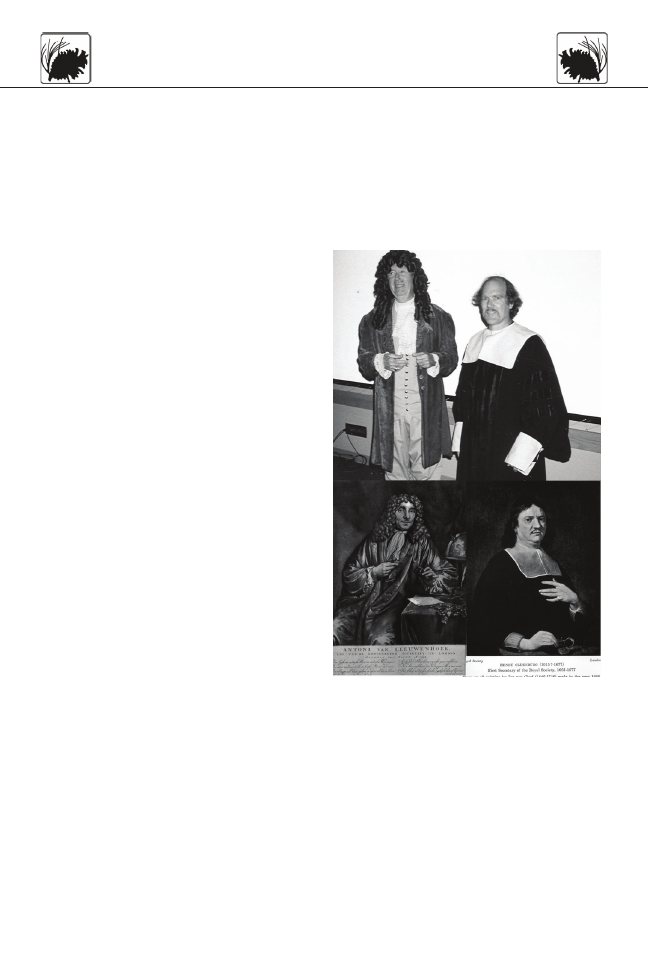
15
The Botanical investigations
of Antoni van Leeuwenhoek
Marshall D. Sundberg
Department of Biological
Sciences
Emporia State University
Emporia, KS 66801
Key words: anatomy, wood, phloem, seeds,
sorus, sporangium
ABSTRACT
Antoni van Leeuwenhoek is well known for his
single lens microscopes and how he used them to
make observations on “little animals,” however, the
breadth of his botanical observations are less well
known. His thorough studies of wood anatomy
are well documented but he also reported on the
leaf anatomy, phloem, numerous seeds, and ferns.
This article is a summary of his major anatomical
findings as well as several of his physiological
experiments on plants, quantitative measurements
and predictions based on his observations, and
descriptions of the economic uses of some plants.
Leeuwenhoek and Oldenburg
Most of us are familiar with Leeuwenhoek
as a 17
th
century Dutch maker of single-lens
microscopes and discoverer of bacteria and
many “little animals,” protozoans and aquatic
invertebrates. (Dobell, 1932; Ford, 1991) You may
have observed that there are multiple spellings of
his name: “in the English versions of his epistles,
published in the Philosophical Transactions, his
surname is spelled in no less than 19 different
ways.” (Dobell, 1932, p.303) In this article I will
use the form chosen by the editors of The Collected
Letters of Antoni van Leeuwenhoek, a 19 volume
compilation by Dutch scientists, in Dutch and
English, of all of Leeuwenhoek’s correspondence
(Leeuwenhoek, 1939). (A recent article even
describes the construction and use of a “replica”
microscope by undergraduate students who then
used it to observe onion leaf peels and mosquitoes
(Sepel, Loreto, and Rocha, 2009). But it wasn’t
until I was invited by the late Larry Crockett to
perform with him in his unpublished three-act
play, “A Market Day in Delft,” that I learned of
Reports and Reviews
Leeuwenhoek’s relationship with Henry Oldenburg
and his series of botanical publications in the
Philosophical Transactions. This brief review of
Leeuwenhock’s botanical work is dedicated to the
memory of my friend, the late Professor Crockett:
botanist, thespian, teacher, and mentor.
[Figure 1. Top, left to right, Larry Crockett (Leeuwenhoek)
and Marshall Sundberg (Oldenburg) in production of “A
Market Day in Delft” presented at the 1994 annual meet-
ing in Knoxville, TN. Bottom, left to right, Antoni van
Leeuwenhoek and Henry Oldenburg. Top image accessed
10/15/2010. http://botany.org/plantimages/Image-
Data.asp?IDN=35-125&IS=700]
In the Epistle Dedicatory to volume 8 (1673),
Henry Oldenburg noted that in this volume there
would be “…some Microscopical additionals
toevince the late improvement of that Instrument
in Holland….” Oldenburg was the founding
editor of the Philosophical Transactions (later the
Received: 11/1/2010; Accepted 2/9/2011

16
Plant Science Bulletin 57(1) 2011
small Particles.” In the thicker material left behind
were the same small particles “of which the Leaf
were made up” and between these particles some
of the pipes “as I said I had seen in the Pores of the
Stalk of the Leaf.” If he held some of the thicker
material to a small flame, the particles burned away
but the pipes remained. Later he examined some
plain sap expressed form the leaves, and from the
stalk of the fruit after the leaves had “faded” and
in both of these exudates he found the little pipes.
“Now ‘tis likely, that these Pipes in this Herb are the
cause of the smart that is felt in chawing the Arum
by the motion of the moist Tongue in tasting.” (p.
381)
Later he noted “…that the motion of the sharp
Particles that are in some saps, was not less” [than
the “very pretty to behold” motion of the “little
globuls” he observed in the juice squeezed from
lemon peels]. (p 382) Furthermore, although
he observed small particles in the sap of many
plants, including ones shaped like “a well-polished
triangular or quadrangular pointed Diamond”, but
the “little Pipes” described in Arum were found in
only a few other plants such as the sap of “green
Vine-branches, and Asparagus…and very many
in the Sap of the Stalk and Leaves of Cataputia
(Spurge)…” (p. 382).
Unfortunately Leeuwenhoek provided no
sketches to support his descriptions in this paper,
but it is clear that he has described the parenchyma
(pores) in the petiole cross section. His “Pipes”
are raphid crystals, either free or clustered within
parenchyma cells, and he observed druses and
prismatic crystals in the expressed sap of other
plants. The “little globuls” with “very pretty motion”
were oil droplets from the glands of his lemon peel.
Wood Anatomy
The following year in his Epistle Dedicatory,
Oldenburg noted: “The curious Anatome of Plants
is here confirm’d, in some main Points, by good
Microscopes.” (Oldenberg, 1676). In this volume
Leeuwenhoek (1676b) included his first botanical
illustration, a detailed cross sectional image of an ash
twig, with an inset tangential section, to illustrate his
description of “the Texture of Trees.” (Interestingly,
the published image in the Philosophical
Transactions (Leeuwenhoek, 1676b) is a mirror
image of the figure Leeuwenhoek submitted in his
letter of April 21 (1676a). Leeuwenhoek’s studies
on wood anatomy are the one area of his botanical
work that is well documented in the literature (see
van Iterson, 1948; Baas, 1982) so I will only briefly
Philosophical Transactions of the Royal Society)
and in that capacity maintained a professional
correspondence with Leeuwenhoek regarding the
latter’s submissions, and sometimes requesting
work on specific topics. For instance, in Letter
No. 18 (Leeuwenhoek, 1675b) Leeuwenhoek wrote
“You had the kindness in your letter of October
26
th
1674 to ask me to examine the sap of plants. I
have examined several saps and observed in them
various figures, of which I have made rough drafts
on paper.” Oldenburg also acted as a go-between for
Leeuwenhoek to communicate with others. Four
months before submitting his first wood anatomy
paper, Leeuwenhoek wrote to Oldenburg: “Dear
Sir, I received your honoured letter of August 12
th
in good order, from which I learned that you have
received my letter of August 14
th 1
). I looked forward
to another letter in order to learn the opinion of the
Gentlemen Amateurs [Nehemiah Grew and Robert
Hooke] (to whom you will have communicated
my writings by now) on my theses, for I expect to
be contradicted, since the speculations set forth
in my letter, will appear strange to some people.
I will be greatly obliged if these objections are
communicated to me.” (Leeuwenhoek, 1675c) Of
particular value in the Collected Letters volumes
cited above are the extensive footnotes that explain
the biology, customs, interpretations, etc., such as
the apparent date inversion between Leeuwenhoek’s
letter and Oldenburg’s reply and the use of the term
“Gentlemen Amateurs” in the latter quotation. The
“microscopical additionals” Oldenberg referred to
was Leeuwenhoek’s (1673a) first contribution to
science, “1. The Mould upon skin…” and “2. The
sting of a Bee….”
Petiole Observations
Two years after his initial article, Leeuwenhoek
(1675a) published his first observations on plants.
He begins by noting that the sap of Arum (Wake-
robin) tasted “very sharp upon the tongue” and that
a cross section of the petiole contained “globuls
not exactly round” which themselves contained
“particles incomparably smaller.” Furthermore,
there were special parts “which I shall call Pores”
[parenchyma cells] and inside the pores were
“heaps” of 10 – 15 “small Figures” that were about
“the thickness of that of a Spiders Web,” but which
appeared to be about “the thickness of a great
Bread-knives back” in his microscope. He later calls
these small figures “Pipes.”[raphid crystals] If he
macerated some of the arum petiole and squeezed
the juice through bleu [filter] paper, nothing was
visible in the strained juice except an “abundance of

17
Plant Science Bulletin 57(1) 2011
Figure 2. Ash wood, Leeuwenhoek (1676b). The largest
figure, 3, is the main sketch of a 1/8 transverse section of
a 1-year old ash stem with fine cellular detail in the pith
and xylem. Figure 1 is a radial section through an “upright
vessel” showing a short series of joined vessels with pitted
walls while Figure 2 is a tangential section illustrating two
fusiform multiseriate rays. (Figure 4 is of a nematode found
in the French wine, the description of which is the last para-
graph of the communication.)
Seven years later Leeuwenhoek (1683)
acknowledged that he was familiar with the
work of Malpighi and Grew, but nevertheless,
ventured “to represent the Vessels in Wood after
such manner as they offer’d themselves to me.”
(p. 198). In this wonderful paper he illustrates
and describes transverse and tangential sections
of six different woods: oak, elm, beech, willow,
alder, ebony, as well as palm and “straw” [probably
wheat]. Leeuwenhoek’s illustrations on a single
fold-out plate illustrate rectangular samples of the
woods, similar to the student laboratory slides we
use today. The transverse sections always include
a transition between growth rings except for the
ebony and palm, “…because that wood grows
in a Climate where it increases always: for the
Island Mauritius lies in a few degrees North of
the Tropic of Capricorn.” (p. 205). In each of the
figures, individual cells are clearly and accurately
represented; pit patterns and angle of the end
walls of vessels can be analyzed. Leeuwenhoek
distinguished between large multiseriate rays and
smaller uni-or biseriate ones, calling them two
types of “Vessels…lying horizontally.” (p 199)
Leeuwenhoek provided a clear description of the
describe some highlights here.
In August,1673, he sent a letter to Oldenburg
differentiating between pine wood, with one type of
“pipe” (tracheids) and describing two sizes of pipes
in the wood of oak. “I have likewise found two sorts
of holes or pipes, one larger (vessels) than the other,
in beech-, ash-, willow-, and vine-wood, as also in
sugarcane and rotan.” (Leeuwenhoek, 1673b). In
this letter he also described “tiny bands” (wood
rays) among the pipes, “white”(spring wood) and
“darker” (summer wood) areas with denser cells,
and speculated on the movement of fluids through
the pipes. The “valves” he describes are bordered
pits. This letter was not published.
Subsequently Leeuwenhoek had the opportunity
to examine Hugen’s copy of Grew’s “Comparative
anatomy of the trunks of plants” and based on the
figures in that text (Leeuwenhoek was unable to read
the English text) concluded that Grew was unaware
of the two types of vessels he had observed. This
was the reason for his illustrated 1676 paper. As a
preface, Oldenburg noted: “These observations, as
to the Texture of Plants, although they (and very
many more) have been already made and published
by Dr. Grew, and by Sign. Malpighi; yet because
that (for the most part) they may be a further
confirmation of the truth of their observations; I
thought it not unuseful to have them communicated
here also.”(Leeuwenhoek, 1675b,p. 656-7) (Grew’s
earlier publications including “Comparative
anatomy of the trunks of plants” were combined in
1682 to become the “Four Books” [sections] of his
Anatomy of Plants). Hutton et al.(1809) expanded
on Oldenburg’s original remarks to justify and
ensure Grew’s priority in describing the structure
of woody stems.
The issue of priority aside, Leeuwenhoek,
provided more accurate individual cellular detail
in his illustrations, particularly shape variation
where large vessels adjoin. His representations of
rays, as well as tyloses in some vessels, are clear and
accurate.
On at least one point, Leeuwenhoek provided a
better interpretation than either Grew or Malpighi,
both of whom stated that the large vessels, pores,
contained only air. Leeuwenhoek stated that “the
greater Vessels [true vessels] sent [sap] upwards,”
but he thought “that some small Particles did again
descend in the smaller Vessels [tracheids]….”
(Leeuwenhoek, 1675b, p. 653).

18
Plant Science Bulletin 57(1) 2011
are I guess about 20000 Vessels.
Hence in an Oak Tree of four foot
Diameter are 3200 Millions of
ascending Vessels, and in one of
1 foot, there are 200 Millions of
Vessels. If we suppose 10 of these
great and small Vessels in a day to
carry up 1 drop of Water, and that
100 of these drips make one Cubick
Inch, there will be 200000 Cubic
Inches. These Inches reduced to
feet, amount to full 115 Cubick feet of Rhinland
measure, of 12 inches to the foot; and one Cubick
foot weighing 65 lib. Of our Delph water, the whole
will amount to 7475 lib. Or 14 Bordeaux Hogsheads
[Bordeaux Hogshead = 220 liters] of water, which
a Tree of one foot Diameter in one day can bring
up. (p. 200).
(As an exercise in Biology of Plants this semester,
I challenged students to test Leeuwenhoek’s figures
by calculating the number of vessels per mm
2
on our oak slides. Only one student took up the
challenge - - her numbers, converted to English
units, were 68,000 cells/in.
2
.)
Fifteen years later Leeuwenhoek (1694) returned
to studying wood and made some observations
concerning the relationship between growth
rate, size, and wood strength. In this short letter
he questioned some of the common opinion
concerning the strength of wood based on his
understanding of wood structure and growth. For
instance, it was believed that timber cut in winter
was stronger than that cut in summer. However,
he noted: “that there is no difference, except in the
Bark and outermost Ring of the Wood, which in the
Summer are softer, and so more easily pierced by the
Worm.” (p 224). His most significant observation
was that the width of the annual rings is related
to growth conditions. “Some of these circles are
broader than others, particularly the Ninth, the
Tree from some accidental Cause receiving more
Nourishment, and growing faster that Year than the
former.” He said,
“he [a correspondent] examined a piece of Ash
growing in Norway, and found it grew 44 years
before its semidiameter was one Inch; whereas Ash
growing about Delft has been observed to increase
an Inch early for several years together.” (p. 225).
There is another 27-year span before
Figure 3. Oak wood sections, Leeuwenhoek (1683),
Figs.2, 3, and 4. Fig. 2, cross section at boundary of
growth rings. E, large vessels, F, multiseriate wood rays, G,
uniseriate wood rays. Fig. 3. Longitudinal section of vessel
containing numerous tyloses. Fig 4, Tangential section
with large multiseriate ray, T-V, pitted vessels, O-N, and
uniseriate rays, P,Q.
formation of annual rings and defines the concept
of “spring wood.” “EEE denote large ascending
Vessels made every year in the Wood in the Spring,
when it begins to grow. These are filled within
with small Bladders, which have very thin Skins,
here expressed in one of the greater Vessels, cut
long ways in the third Figure….” (p. 199). The
figure he refers to is a portion of an oak vessel, in
longitudinal section, with obvious tyloses filling
the lumen. Later, in willow, “… the great ones
[vessels] beset with little parts, seeming Globuls.”
(p. 204) He also described one sort of “rising
Vessels” as being “…also speck’t with parts which
by a common Microscope appear like Globuls, as
Fig 4. ON where one of the said Vessels is cult long-
ways.” (p. 199) Again referring to oak, this figure
is a tangential section where pitted side walls are
evident the length of the vessel running from O
to N, top to bottom of the image. This figure also
shows an area with numerous biseriate rays adjacent
to a large multiseriate ray. In elm he also describes
pitted vessels: “HH Shews one of the great rising
Vessels in length, cut cross in the midst; yet when
we observe the same more exactly we see that they
consist of very thin Films, beset with Helical Threds
[sic], exhibiting obscure spots upon the hoops or
bows as Fig 3.” (p. 203)
Extremely interesting are Leeuwenhoek’s
quantitative musings, 44 years prior to Hales’
Vegetable Statics (1727).
All these ascending Vessels in the aforesaid piece
of Wood, which is about 1/90 of a Square Inch,
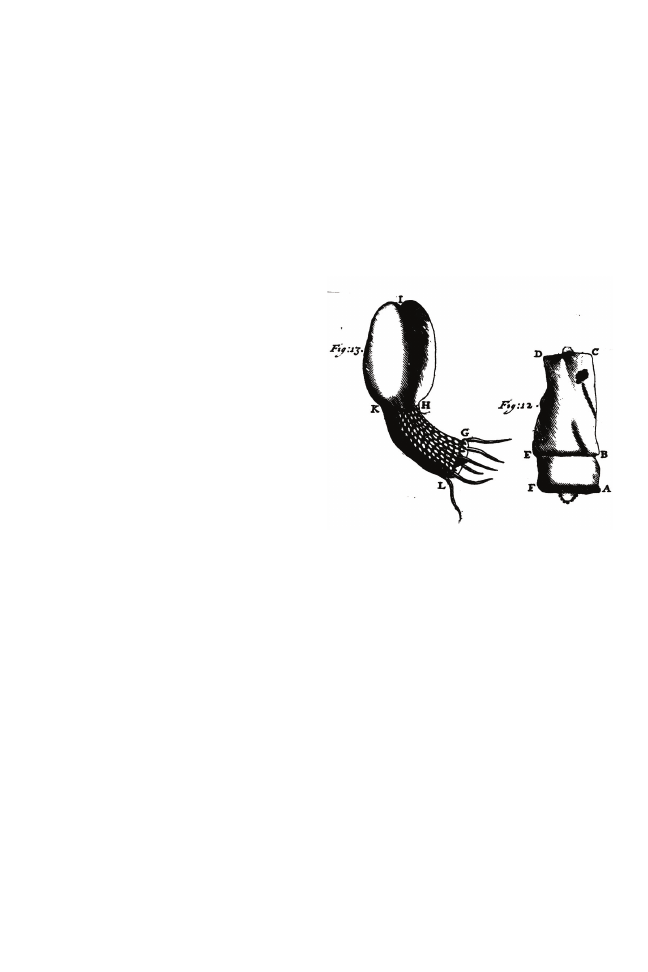
19
Plant Science Bulletin 57(1) 2011
surprized [sic] to find a Variety from what I then
wrote concerning the Mealy and Oily substance…I
found no Mealy Substance at all [in cotton], but
four small Leaves enwrapping one another…” (P.
949). Leeuwenhoek’s recognition of endosperm
was significant. Although Grew (1682) has a small
chapter and an early section of the first chapter
dedicated to the anatomy of seeds, he concentrated
on beans and other legumes, or stone fruits. Thus,
he made no mention of the endosperm or its role
is food storage to support the dormant embryo in
the seed.
Figure 4. Organ development during willow embryo
germination, Leeuwenhoek (1693a) Figs. 12, 13. Fig. 12,
12-hour dried embryo ABEF is ring-shaped wall around
radicle sometimes referred to as a collet, ; Fig 13, 36 hr
seedling, Cotyledons, I, cotyledonary node, HK, hypocotyls
axis, HK-GL and branch roots growing from collet, GL.
A second major observation of Leeuwenhoek
(1693a) is a “ligament, made up of several Vessels
also…” (p. 702) [the funiculus] which attaches
the developing seed to the fruit wall. For ash he
diagramed two spirally coiled xylem vessels that
were dissected from the “ligament.” In filberts,
this structure is substantial enough that he could
make and illustrate a hand cross section showing
the numerous vessels. “…the Embrio [sic] which
is to be the future Plant, perhaps a Tree is so long
contained in that Body which we call the Seed, and
fed by means of a Ligament from its Matrix, to wit,
the Tree, till it be of a competent growth, and has
a sufficiency to provide for it self [sic], and grow
when exposed on the bare ground, and then it is
no longer kept up…This Nourishment is a sort of
Flour which encompases the Embrio [sic] Plant,
Leeuwenhoek’s (1721a) next, and last, botanical
contribution to wood anatomy - - a short
description, unillustrated, of an unknown tropical
wood and further observations on the “ascending
Vessels” of oak and fir. In oak he describes pits.
“…in Oak I found some other Vessels, which
enter’d into their sides and appear’d to me like so
many small round holes, especially where the
Horizontal Vessels lay, which I judge to be united
to the ascending Vessels, by means of those small
Orifices, and thereby to discharge part of their Sap
into them.” (p. 136)
I have likewise made some Observations upon
Fir Wood, in which the ascending Vessels consist of
so very fine and thin a Substance, that they exhibit
a very delightful Spectacle in the Microscope. In
these ascending Vessels I imagin’d that I saw some
Globules, with a small opening in their middle,
which seem’d to be of a closer and denser Substance
than the rest of the Wood. But I afterwards found
myself mistaken, and that these supposed Globules
were nothing else but the Orfices [bordered pits],
whereby the ascending and horizontal Vessels were
united together, and through which the sap was
carry’d from the one to the other. (p. 136)
Seeds and Fruits
Already in 1676 Leeuwenhoek (1676c) wrote
to Oldenburg about the structure of peppercorns
and wheat seeds and vascular bundles in the fruits
of several plants, however, this work and several
subsequent letters concerning seeds and fruits
were not published. Finally, in 1693, Oldenburg
published two papers describing the anatomy of
seeds (Leeuwenhoek, 1693a,c) and this was from
a letter sent by Leeuwenhoek on July 13, 1685!
Leeuwenhoek’s most extensive observations were
on ash, filbert, and willow seeds in the first paper.
In his discussion of the two large leaves [cotyledons]
of the ash embryo he described how the “liquor or
sap” conveyed in the “vessels” [veins] is transported
laterally form one “globule” [cell] to the next in
the interstitial parenchyma [by diffusion] “…as if
you should put several small Pellets of dry’d Clay
in a glass Vessel, if the Water touch but one of
them, you will find it communicated by that to the
Second, Third, and so on till they are all Wet.”(p.
701) He also noted that “every Seed containing not
only the Rudiments of the future Plant [embryo],
but also a certain fine flower [sic][endosperm] to
nourish it so long, till striking Root into the Earth,
it may thence receive its Nutriment.” (p. 701) He
modified this statement in the later paper - - “I was

20
Plant Science Bulletin 57(1) 2011
by boiling the leaves, mixing with oil, and drinking.
In half an hour convulsions and other symptoms
(detailed by Leeuwenhoek) commence. Ever the
experimentalist, Leeuwenhoek cracked some of
the seeds and soaked them in clean rain water for
a few hours. “I took a little of the Water and mixed
it with my Blood, as it dropt from my Finger by the
pricking of a Needle, and I immediately observed
that the Blood was extreamly [sic] coagulated,
yea, more than I had ever seen it in my Life…
the Particles of Globules [of the blood which is
normally bright red in water] did assume a Blackish
or Dirty Colour.” (p. 2206).
While Leeuwenhoek’s anatomical description
of the coffee seed (Leeuwenhoek, 1687) was not
published, in the 1706 paper he described coffee
use by the Moors. “If a person that is not us’d to
it should take but10 or 20 grains, ‘twould have the
same effect as if they had drank 10 Bottles of Wine.”
(p. 2207-8) If used too often it has the effect of
“depriving them of their Memory together with the
Appetite, and at last making them so lean, that they
would have hardly any Flesh upon their Bones…”
A drink called “Bosta” is a mixture of the Canfie
[coffee]drink with seeds of poppies. “This Seed
is little used by them in Physick, tho I doubt not
that it might be excellently well apply’d, because
it does not only imitate the effects of Opium, but
also, if there be not too much of it us’d at a time,
it has the same operation as the best Wine” (p.
2208). In the last page of the paper he describes the
dissected embryos of these seeds, and hemp seed
for comparison.
In his last botanical paper (1721b) he
acknowledged that in his studies of seeds he
often observed the “so called Membranes, in
which the Substance of Meal, or Flower [sic], is
inclosed, like little Packets in Cells or Boxes[storage
parenchyma filled with starch grains]…. I at
length, with astonishment, discovere’d very plainly,
that what I call the membranes, were endured
with an unspeakable number of little Holes, thro’
which, in many places, one might perceive the
Light;” (p. 200). Leeuwenhoek apparently was
describing simple pits in the parenchyma cell walls.
Unfortunately, he provided no illustrations for this
final contribution to plant anatomy. He continued
with some speculation on the function of these
pores.
…the Orfices of Seeds are so form’d, that many
of their little Vessels do admit Moisture to pass
and in the Seed make the two Lobes.” (p. 703-4).
A final innovation in this paper is his
documentation of early organography during
germination. He laid willow seeds on moist sand
in his closet and made subsequent observations
after 36 and 72 hours. Emergence of the radicle,
elongation of the hypocotyls and development of
the cotyledons and branch roots are well illustrated
in his figures 12-13.
In 1696 Leeuwenhoek was finally successful
in making adequate preparations to describe
the embryos in seeds of figs and strawberries (he
tried but was unsuccessful in his 1693 paper).
His descriptions, however, are most notable for
economic botany and ecology and remind us of
his interest and facility in math. Concerning figs:
“I opened one Fig which I thought to be good and
well tasted, and in it I saw some hundreds of Mites
creep about, that did crawl in the inside of the Fig;
so that when we eat Figs, we send, unknown to us,
many Thousands of these little Animals into our
Stomachs.” (p. 274)
Now if we see that a common Fig has between
four and five Hundred Seeds, and that one Tree
doth Yearly produce many Figs, and that every
ripe Seed of a Fig can produce a whole Tree; and
consequently, if a Country was planted all over
with Fig-trees, it may produce so many Fig-trees
in a Year, that we might not only Plant a whole
Kingdom all over with Fig-trees, that all these Seeds
might produce, but also the whole earthly World;
and that this doth not only succeed in Fig-Trees,
but many other; ….We have reason to lay our Hand
upon our Mouth, and think that the Almighty has
thought this convenient, for the Procreation of
all that has moving and growing; and thus all our
Reason is but guessing, and that the true Reason is
to us incomprehensible. (P. 277)
Similarly, when considering the seeds on a
strawberry “We must again lay our Hand upon our
Mouth, and be astonished at the increasing and
great multiplicity of Seeds of this Plant.” (P. 278).
Ten years later Leeuwenhoek (1706a,) returned
to the study of seeds but this time most of the
paper is an ethnobotanical description of the uses
of these seeds, or the plants that produce them.
The first, from a tree he called Euwane, ‘Tis used
inwardly by no body, excepting some Women, that,
disagreeing with their Husbands, make use of it in
order to kill themselves; it being consequently a
certain Poyson [sic].” (p. 2205) The poison is made
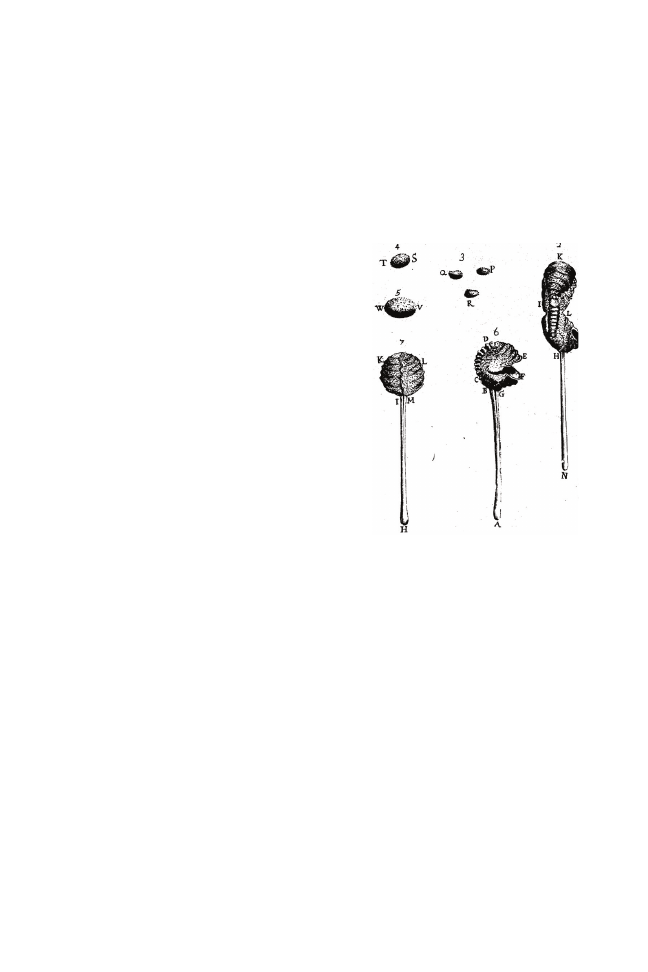
21
Plant Science Bulletin 57(1) 2011
inwards, and accordingly Water is driven into them
by the pressure of the Air, and causes the Seed to
swell; upon which, a Warmth and Fermentation
succeeding in the Seed, it requires a greater space,
and by the particular Formation of the Particles,
which lie in the Cells, and which have derived their
Encrease [sic] from the Cells, the mealy Substance,
of which they consist, is partly driven out of them
into the body of the young Plant, which by this
means increases so much in bulk, that the Root
is now able to supply it with Nourishment from
the early, at which time the Seed is found to be
diminished in its bigness. (p. 202)
Leeuwenhoek’s physiology may be incorrect, but
his anatomical observations were excellent. His
last paragraph may be viewed as a summary of his
career in science and as an inspiration to scientists
today. The key to success is persistence and careful
observation.
As often as I have view’d Seeds, for several Years
past, with the Microscope, yet I never imagin’d
that the little Cells were endued with so many
Vessels, tho’ I have often been considering, how the
Intrusion of the Particles of the Meal, or Flower,
into the Membranes was effected; nor should I ever
have attained thereto, but by continual Labour in
the investigation of things, which are concealed
from our naked Eyes, and towards which I have a
much greater inclination, than what I observe in
most other men.
Ferns
Leeuwenhoek’s (1705) descriptions and
experiments with fern “Seed-Vessels and Seeds”
[sporangia and spores] are worthy of incorporation
into a modern laboratory manual. He began by
describing a walk where he came upon a patch of
Polypodium ferns having a great number of “Seed
Vessels” [sporangia] on its leaves “…soon one and
soon another of them burst before our Eyes, which
spectacle seem’d exceeding strange to us.” (p. 1868).
That winter he was given some leaves of Oak Fern
and he noticed that it too had seed vessels but that
these were much larger than those of the polypod
and this time “I observed several little Bundles of
Parcels of these Seed Vessels, sometimes thirteen
of them lying in a row by one another.” [sori]. (p.
1868) So he went out, in February, to collect some
polypods to grow and observe in his study.
His first illustration, the “greater part” of one
of these leaves (he has now employed a painter to
do his drawings), “..to shew you the many Seed
Vessels that are upon the same, together with the
unspeakable number of small Seeds that are shut up
in each Vessel.” (p. 1869) He noted that in a single
row “on one branch only of such a leaf” [pinna]
there may be “13 of those little Particles, which to
the naked Eye appear like Roses [sori]…and when
I separated one of these Seed Vessels from the rest,
I observed that all of them had very short kind of
Stalks, whereby they were fastened to the Leaf, and
by which they received their Increase…and the Leaf
Figure 5. Polypodium sporangia, Leeuwenhoek (1705). Fig.
2. Dorsal view of opened sporangium, showing annulus.KO,
stomium, M, and sporangium stalk, HN. Fig 6, side view of
sporangium beginning to open. annulus, GBCD; stomium,
Figure 7, unopened sporangium.
seem’d clearer or more transparent there, in which
place I judge there was a Canal or Vein of the
leaf.”(p. 1870) He carefully dissected several of
these sori and counted from 120 to 140 sporangia
in each. Unlike the summer, however, all of them
were open and contained no “seed”[spores]. “This
openness seem’d at first very strange to me, because
I could not perceive in any of them that it was
occasion’d by any bursting or breaking in pieces;
but when I’consider’d the matter better, I fancied
to my self that Nature had ordered it so in those
Seed Vessels, that as soon as the Seed was ripe, and
received no further Nourishment, the Seed Vessels
should open of course.” (p 1870).
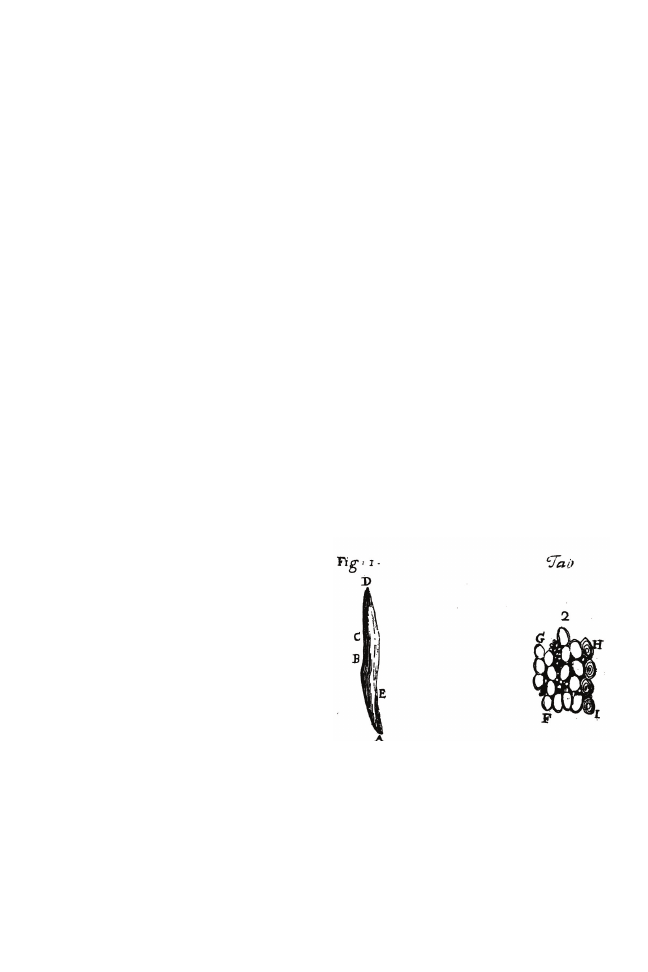
22
Plant Science Bulletin 57(1) 2011
always observed that almost all the Seed Vessels
shut up themselves, just after the same manner as
they were before they discharged their Seed; and
when I spread those Seed Vessels abroad, and let
them dry again, they were all of them as open as
that which is represented by Fig. 2. (p. 1874)
Bark
While Leeuwenhoek purposely omitted the
bark from his descriptions of the stem of ash in
1676, he turned to this subject in his second paper
of 1693(b). Unlike Grew (1682), who provides a
detailed description of a number of different barks
in his chapters on roots and stems, Leeuwenhoek
made some generalized comparative descriptions
of about a dozen species. Most of the species he
examined had “vessels” [sieve tube elements]
running “upwards” in the bark and those barks
“…grows thicker as the Tree increases, the outside
cracking grows Dead, and sticks to the young Bark
underneath, which is the only living Part of the
Bark.” In a few trees the “vessels” in the bark “run
round the Tree; for as the Tree increases in Vessels
not being able to Stretch nor Separate from each
other, must necessarily break asunder; so that the
Old Bark is easily Separated and falls off from the
New.” (p. 841) Furthermore, he states that because
Figure 6. Phloem, Leeuwenhoek (1706b). Figure 1, sieve
tube element in longitudinal view. Fig 2, phloem cross sec-
tion with sieve cells, FG, tiny companion cells with dark
walls, and four phloem fibers HI.
of the horizontal “vessels” [xylem rays] he described
earlier in the wood, “the Bark…is produced and
nourished from the Trunk of the Tree…” (p. 841).
His second paper on bark (1706b) was a closer
examination of the bark of a tree he calls “China
Detained examination of the opened sporangia
revealed “8 Screw-like parts” [an annulus] one each
one.
Let us suppose now that when the Seed is ripe,
and receives no further Nourishment, it, and
particularly its Shell or Vessel, which for the most
part is composed of a thin Membrane, shrinks in, by
reason that its moisture in dry weather is all exhal’d;
now this shrinking in is greater in the 8 Screw-like
parts, that are described between H and O, than in
any other part of the Seed Vessel, because that the
Screw-like parts are there of more than an ordinary
thickness, in comparison of the other parts of the
Seed Vessels; by which extraordinary shrinking the
Seed Vessels are forc’d open, and the inclosed Seed
[spores] thrown out. (p. 1871)
He went on to describe the individual spores,
which are slightly oval, yellowish, and have a
sculptured surface, and that 50 or more are
contained in each sporangium. He suggested that
the sporangia are produced and fed by the veins
of the leaf and that they, in turn, “are fed from
the same.” In analogy to his previous studies of
seeds, he postulated that each spore must also be
“indued with particular Canals of Vessels” (p. 1872)
to supply them. In breaking open a spore “I was
mightily surpriz’d to find a great deal of Oyl coming
out of one of them; and as each of these Seeds was
of a Yellowish Colour, so was the Oyl also, where
‘twas a little thick; but where it was thinner, it was
a clear as any Water; the other Particles that lay in
and about the Oyl, were of an exceeding smallness.”
(p. 1873) Because of this small size “it is easie [sic]
to conceive how the same, after that they are full
ripe, may be scatter’d abroad with a brisk Wind…”
(p. 1873-4).
The most interesting part of the article, however,
is the last paragraph where he described some
experiments to investigate how the sporangia
released their spores.
For my further satisfaction in this matter, I
took a Fern Leaf, in which the Seed Vessels being
quite ripe, were for the most part open, and had
discharged their Seed, and put it into boyling [sic]
hot Water; in this expectation, that the hot Water
insinuating itself immediately into the Screw-like
parts, as they are represented in Fig. 2. Between H
and O, would so extend or swell out those parts,
that the Seed Vessels would resume the same figure
or appearance as when they were full of Seed;
and this Experiment I repeated several times, and

23
Plant Science Bulletin 57(1) 2011
the Wood, as I often said before, and from whence
also I conclude, that the above mentioned Particles
receive their increase [sic]….the above mentioned
Particles, so as they are cut across, whereby
they appear in an Oval Figure [crescent-shaped
secondary phloem separated by dilated phloem
rays]; and if we view them very nicely we may
discover, that [a small part of the particles] they are
composed of Screw-like Parts [phloem fibers]…”(p.
2448). The sieve cells, companion cells, and phloem
fibers are illustrated in his Fig. 2 (Fig. 6).
Conclusion
Leeuwenhoek’s observations are clearly
remarkable, and it has sometimes been suggested
that they were in part due to a vivid imagination.
We all know that a small number of his original
microscopes exist (at least 26 additional
microscopes, known to have been given to the
Royal Society, along with separate dried specimens,
have been lost; Ford, 1991, foreward and p. 130,
164), and they have been demonstrated to produce
magnifications of up to 266 X and a numerical
aperture of up to 0.37 (on an 110X lens; Ford, p.
166). Furthermore, a few of his samples exist,
including hand sections of cork and elder pith.
Ford provides a wonderful chapter comparing
Leeuwenhoek’s lenses with modern Leitz lenses
of comparable magnification and Leeuwenhoek’s
hold up very well indeed in the areas of focus
(they are obviously not “flat field”). Similarly, his
hand-sectioned specimens, observed with SEM,
are comparable to modern microtome-produced
material! In his papers on wood and seeds, he
frequently describes his preparations techniques;
soaking or boiling in water, soaking in brandy or
wine, etc. which were required for him to make
sections of these hard materials with his straight-
edge razor. He is an inspiration for my botany
students struggling to produce adequate sections of
herbaceous material with their half-double edge blades!
Acknowledgement
I thank Laura Rosalie Davis for her efforts
to determine cell counts/inch in oak wood for
comparison with Leeuwenhoek’s estimates and two
anonymous reviewers for their useful critiques.
China” – probably Cinchona “which is made use
of with success in the most Obstinate Fevers” (p.
2446). The first part recalled his conversation
with Angelus van Wikhuysen, a physician from
Middleburgh, who supplied the material and who
shared his methods of preparation. For his part,
Leeuwenhoek recounted his understanding of the
growth of bark.
Our Discourse amongst other things rolled upon
this Topic, That between one Bark and another
there is a great deal of difference; for in all Woods
that are known to me, the Bark proceeds out of the
Wood, and every Year there is produced a new Bark
between the Wood and the old one of the former
Year, by which means the Barks of Trees grow
every Year thicker and thicker; so that at length
the extreamest Bark that lies farthest from the Tree
does not only receive no nourishment, but also dies,
so that that which before had a taste in it becomes
altogether tasteless, as I have shewn pon [sic] other
Occasions; and consequently those Barks, which
we call China China, are best when separated from
the youngest Trees. (p. 2446)
Leeuwenhoek proceeded with some remarkable
descriptions of secondary phloem and phloem
rays. He began by describing some of the “long
Particles,” [fusiform-shaped series of sieve cells]
pointed at both ends running lengthwise through
the bark, “Some of which, at first view, one would
judge to be twice or thrice as long as the rest; but
examining them more nicely, I found that they were
several
Particles sheathed, as it were, within one another,
in such a manner, that without looking very close
upon them, would take them to be one continued
Particle. (p. 2447) His illustration and description
of a single cell emphasizes the “small dent” where
adjoining cells connect. “…but I never observed
any thing like this in other Barks of Trees that I
have examined, save only in that which is called
Cinnamon.” (p. 2448)
He then described a cross section through some
of these same long particles and had his artist
sketch a small block of these cells. “I have seen six
of them lie so near one another, that you could but
just distinguish the Number of them [companion
cells], and that which divides these long Particles
from each other is only the Vessels [phloem rays]
that compose part of the Bark, and proceed from

24
Plant Science Bulletin 57(1) 2011
van Leeuwenhock, Volume 1: 3-15, Plate II.
Amsterdam: Swets & Zeitlinger.
LEEWENHOECK, MR. 1676b. Extract of a
letter written to the publisher by Mr. Leewenhoeck
from Delft, April 21, 1676; Concerning the texture
of trees, and some remarkable discovery in Wine;
together with some notes thereon. Philosophical
Transactions 11: 653-660 plus figure.
LEEUWENHOCK. ANTONI. 1676c/1939.
Letter no. 26 in: The collected letters of Antoni van
Leeuwenhock, Volume 1: 129-143. Amsterdam:
Swets & Zeitlinger.
LEEWENHOECK, ANTHONY. 1683. An
abstract of a letter from Mr. Anthony Leewenhoeck
of Delft to Mr. R.H. concerning the appearances
of several woods, and their vessels. Philosophical
Transactions 13: 197-208.
LEEUWENHOCK. ANTONI. 1685/1957.
Letter no. 85 in: The collected letters of Antoni
van Leeuwenhock, Volume 5: 215-269, 17 figures.
Amsterdam: Swets & Zeitlinger.
LEEUWENHOCK. ANTONI. 1687/1961.
Letter no. 99 in: The collected letters of Antoni
van Leeuwenhock, Volume 6: 223-249, 6 figures.
Amsterdam: Swets & Zeitlinger.
LEEUWENHOEK, ANTH VAN. 1693a. A letter
from Mr. Anth. Van Leeuwenhoek concerning
the seeds of plants, with observations on the
manner of the propagation of plants and animals.
Philosophical Transactions 17: 700-708.
LEEUWENHOEK, ANTH. VAN. 1693b. An
extract of a letter from Mr. Anth. Van. Leeuwenhoek,
containing several observations on the texture of
the bones of animals compared with that of wood:
on the bark of trees; on the little scales found on the
cuticula, etc. Philosophical Transactions 17: 838-843.
LEEUWENHOEK, ANTHONY VAN.
1693c. An extract of a letter from Mr. Anthony
van Leeuwenhoek, to the R.S. containing his
observations on the seeds of cotton, palm, or date-
stones, cloves, nutmegs, goose-berries, currans,
tulips, Cassia, lime-tree: on the skin of the hand,
and pores, of sweat, the crystalline humour, optic
nerves, gall, and scales of fish; and the figures of
several salt particles, etc. Philosophical Transactions
17: 949-960.
LEUWENHOCK, ANTHONY VAN. 1694. The
Extract of another letter from Mr. Anthony van
Leuwenhock, to the Royal Society; Concerning
the difference of timber growing in different
countries, and felled at different seasons of the year.
Philosophical Transactions 18: 224-225.
Literature cited
BAAS, PETER. 1982. Leeuwenhoek’s
contributions to wood anatomy and his ideas on
sap transport in plants. In: L.C. Palm & H.A.M
Snelders. Antoni van Leeuwenhoek 1632-1723.
Studies on the life and work of the Delft scientist
commemorating the 350
th
anniversary of his
birthday. Amsterdam: Rodopi.
DOBELL, CLIFFORD. 1932. Antony van
Leeuwenhoek and his “little animals.” New York,
Harcourt, Brace and Company.
FORD, BRIAN J. 1991. The Leeuwenhoek
Legacy. Bristol, UK: BioPress Press.
GREW, NEHEMIAH. 1682/1965 reprint. The
anatomy of plants: with an idea of a philosophical
history of plants and several other lectures read
before the Royal Society. New York: Johnson
Reprint Corporation.
HALE, STEPHEN. 1727/1969 reprint. Vegetable
statics. London: Macdonald & Co.
HUTTON, CHARLES, GEORGE SHAW, and
RICHARD PEARSON. 1809. The philosophical
transactions of the Royal Society of London from
their commencement in the year 1665, to the
year 1800. Abridged, with notes and biographic
illustrations. Volume 2, 1672 – 1683. London: C.
and R Baldwin.
LEEWENHOECK, M[r.] 1673a. A specimen
of some observations made by a microscope,
contrived by M. Leewenhoeck in Holland,
lately communicated by Dr. Regnerus de Graaf.
Philosophical Transactions 8: 6037-6038.
LEEUWENHOEK, ANTONI. 1673b/1939.
Letter no. 2 in: The collected letters of Antoni van
Leeuwenhock, Volume 1: 53. Amsterdam: Swets &
Zeitlinger.
LEEWENHOECK, MR. 1675a. Other
microscopical observations, made by the same,
about the texture of the blood, the sap of some
plants, the figure of sugar and salt, and the probably
cause of the difference of their taste. Philosophical
Transactions 10: 380-385.
LEEUWENHOCK, ANTONI. 1675b/1939.
Letter no 18 in: The collected letters of Antoni van
Leeuwenhock, Volume 1: 303. Amsterdam: Swets
& Zeitlinger.
LEEUWENHOCK, ANTONI. 1675/1939c.
Letter no. 19 in: The collected letters of Antoni van
Leeuwenhock, Volume 1: 331. Amsterdam: Swets
& Zeitlinger.
LEEUWENHOCK. ANTONI. 1676a/1939.
Letter no. 22 in: The collected letters of Antoni

25
Plant Science Bulletin 57(1) 2011
LEEWENHOEK, MR. 1696. An extract of a
letter from Mr. Leewenhoek, dated the 10th of July,
An. 1696. Containing microscopical observations
on eels, mites, the seeds of figs, strawberries, etc.
Philosophical Transactions 19: 269-280.
LEEUWENHOEK, ANTHONY VAN. 1705.
Observations on the seed-vessels and seeds of
Polypodium. In a letter from Mr. Anthony van
Leeuwenhoek, F.R.S. Philosophical Transactions
24: 1868-1874.
LEEUWENHOEK, ANTHONY VAN. 1706a.
Microscopical Observations on the seeds of
several East-India plants, by Mr. Anthony van
Leeuwenhoek, F.R.S. Philosophical Transactions
25: 2205-2209.
LEEUWENHOEK, ANTHONY VAN. 1706b.
Microscopical Observations on the cortex
peruvianus: By Mr. Anthony Van Leeuwenhoek,
F.R.S. Philosopical Transactions 25: 2446-2455.
LEEUWENHOEK, MR. 1721a. Observations
upon the vessels in several sorts of wood, and upon
the muscular fibres of different animals. By the
same curious and inquisitive person. Philosophical
Transactions 31:134-141.
LEEUWENHOECK, MR.: CHAMBERLAYNE,
JOHN. 1721b. Observations upon the seeds
of plants. By the same. Translated by John
Chamberlayne, Esq. Philosophical Transactions
31: 1720-1721.
LEEUWENHOEK. 1939. The collected letters
of Antoni van Leeuwenhoek. 19 Volumes.
Amsterdam: Swets and Zeitlinger.
OLDENBURG, HENRY. 1673. Epistle
Dedicatory. Philosophical Transactions 8.
OLDENBURG, HENRY. 1676. Epistle
Dedicatory. Philosophical Transactions 11.
SEPEL, LENIRA M.N., ELGION L.S. Loreto,
and JOÃO B.T. ROCHA. 2009. Using a replica of
Leeuwenhoek’s microscope to teach the History
of Science and to motivate students to discover
the vision and the contributions of the first
microscopists. CBE-Life Sciences Education 8: 338-
343. http://www.lifescied.org/cgi/reprint/8/4/338
VAN ITERSON, G. 1948. A discussion of
Leeuwenhoeck’s drawings and descriptions in
his letter of 12 January 1680, as compared with
those by Marcellus Malpighi and Nehemiah Grew
of corresponding objects. Pp 435-441. In: The
Collected Letters of Antoni van Leeuwenhoek III.
PUBLISH WHERE IT MATTERS
A testimonial from a recent author in the American Journal of Botany:
“I have had an excellent experience with the copy editing & typesetting
process at AJB. As more and more of the jobs get sent overseas and
the overall quality declines, this is something I have come to really appreciate
as an author and it is likely to encourage my return to AJB.”
THE AMERICAN JOURNAL OF BOTANY
A Scientific Society Publisher
www.amjbot.org

26
Books Reviewed
Ecological
Botanic Gardens: Modern-Day Arks
Sara Oldfield.
2010. ISBN 978-0-262-01516-5. 240 pages.
MIT Press. Cambridge, Massachusetts USA.
The title for this book, “Botanic Gardens: Modern-
Day Arks” is absolutely brilliant. It brings to mind
all the right mental images for the role of botanic
gardens in today’s ever-changing world. Botanic
gardens have been around of a long time. Often
their image is that of a delightful but somewhat
antiquated institution, perhaps because of the
beautiful Victorian-era conservatories in some
of the more well-known gardens. But this image
is very far from the modern-day truth as botanic
gardens currently have an increasingly vital role
to play in the future of plant biodiversity (and by
association animal, and even ecosystem) survival in
our changing world.
Almost all botanic gardens have a “pretty face”,
showcasing the glorious wonders of the botanical
world far and wide no matter where they are located.
The general public can see and appreciate not only
the ornamental and native plants, but also plants
that grow wild in faraway places that the viewer
could not even have imagined existed otherwise.
This book, with a wealth of gorgeous images from
all over the world, certainly is large enough to be a
coffee table book of just pretty pictures. However
its goal is to highlight the conservation, research
and education roles of botanic gardens. Its very
real value is in the fascinating text about sixteen
different botanic gardens, about half in temperate
areas and half in the tropical realm.
Several of the botanic gardens described here were
established in European countries (Royal Botanic
Gardens, Kew and Edinburgh, Berlin and France,
for example) that for years have sent their botanists
Ecological
Botanic Gardens: Modern-Day. Arks Sara Oldfield - Joanne M. Sharpe. ...................26
Globalization and Agricultural Landscapes: Change Patterns and Policy Trends in
Developed Countries. Pimdahl, Jǿrgen, & Simon Swaffield (eds).Lawrence C. Davis .27
Mapping Species Distributions. Spatial Inference and Prediction. Janet Franklin -
Marcel Rejmanek ............................................................................................................29
Economic Botany
Ethnoveterinary Botanical Medicine. Katerere, David R., and Dibungi Luseba, Eds.
Carolyn Wetzel ................................................................................................................29
Historical
The odyssey of a woman field scientist. A story of passion, persistence, and patience.
Jean H. Langenheim - Carol C. Baskin ..........................................................................31
Phycological
A Color Atlas of Photosynthetic Euglenoids. Ionel Ciugulea and Richard E. Triemer -
John Z Kiss.. ...................................................................................................................32
Systematic
Aquatic Plants of Wisconsin. Skawinski, Paul - Donald H. Les ...................................32
The Book of Leaves: a leaf-by-leaf guide to six hundred of the world’s great trees.
Allen J. Coombes - Joseph E. Armstrong.. ...................................................................34
Diversity, Phylogeny, and Evolution in the Monocotyledons. Ole Seberg, Gitte
Peterson, Anders S. Barfod, and Jerrold I. Davis (eds) - Isabel Marques .....................34
Gymnosperms of the United States and Canada. Elray S. Nixon illustrated by Bruce L.
Cunningham.- Neil A. Harriman ...................................................................................36
Seeds of Amazonian Plants. Fernando Cornejo and John Janovec. -
David L. Gorchov... ........................................................................................................37
Systema Naturae 250: The Linnaean Ark. Polaszek, Andrew (editor).
Neil A. Harriman ...........................................................................................................38

27
Plant Science Bulletin 57(1) 2011
all over the world to help less “developed” countries
by collecting and sending home living and pressed
specimens of their flora. Such dedicated and
hard-working botanists were often unaware of
the elaborate taxonomies and plant knowledge
held by the indigenous people. But today that is
changing and the emphasis is on collaboration
and on encouraging the local staff to run their
own botanic gardens and projects. The Nezahat
Gokyigit Botanic Garden in Istanbul Turkey, is an
example: the original flora of Turkey was produced
by the Royal Botanic Garden Edinburgh, but later
volumes were written by local botanists based in
Turkey. Currently the two gardens exchange staff
for a truly collaborative approach to horticultural,
education and conservation work.
While each botanic garden has its own
personality and focus, I think it is fair to say that
it is an institutional form recognized and respected
throughout the world. They are generally located
on relatively small areas of land (250 acres or more
would be a large botanic garden) often in cities
or suburbs of cities (for example, the 160 botanic
gardens in China, some of which are described
in the chapter on South China Botanic Garden).
Therefore, the challenges of population pressure
on biodiversity commonly encountered by the
management of large preserves and parks are
less of a problem in a botanic garden. This book
demonstrates that while a botanic garden may
not be able to protect a large number of species
ndigenous to their small site, the living collections,
research programs and outreach can be of national,
regional or even global importance.
My only (very minor) criticism of this book is the
use of acronyms, especially in the introductory
chapters. Although the author works for the
Botanic Gardens Conservation International
(BGCI), I doubt that many of the intended readers
of the book have any idea what the acronym stands
for and yet it is repeated several times before being
interpreted on page 19. Even after identifying the
meaning of an acronym (for example, GSPC =
Global Strategy for Plant Conservation), I suspect
the reader will immediately forget and then have to
look back. There is a good index and also short lists
of further reading and other organizations acting
as conservation advocates at the back of the book,
but this section should be perhaps referenced in the
introductory material.
Each chapter of the book, though nominally
describing a single botanic garden, actually
describes a different system of interactions among
people and institutions throughout the world.
The introduction and summary chapters also give
more examples from other botanic gardens. Each
garden’s focus on research and conservation is
unique, thus the book provides a user-friendly
introduction to many subjects worthy of further
study in an undergraduate or botanic garden
classroom such as plant genetics, micropropagation,
extinction, invasives, ex situ horticultural methods,
ethnobotany, and community relations, to name but a
few.
-Joanne M. Sharpe, Coastal Maine Botanical
Gardens
Globalization and Agricultural Land-
scapes: Change Patterns and Policy
Trends in Developed Countries
2010. ISBN 978-0-521-73666-4.
(Paper US$59.00) 275 pp.
Cambridge University Press
32 Avenue of the Americas
New York, NY 10013.
Landscape Ecology as a discipline makes direct use
of botany to a limited extent, but it must necessarily
deal in broader generalizations, in order consider
geology, meteorology, sociology and a dozen other
“ologies” too. However, even such a broad subject as
landscape ecology is only one facet of globalization.
Globalization as a phenomenon may be largely
about the “space of flow” more than the “space of
place” as referred to by Castells. This book attempts
to deal with both kinds of space.
Primdahl, from Denmark, and Swaffield, from New
Zealand, have edited a volume attempting to give
a broad survey of some issues of globalization in
relation to agricultural landscapes in developed
countries. This means, of course, that much of
the world’s land, and a very large fraction of its
population, is not explicitly considered. Another
volume addressing the less developed and rapidly
developing countries would likely identify many
of the same themes, but translated into myriad
forms. Even within the developed OECD countries
only a few are considered in any detail. While
every country, and region, will show significant
differences from the case studies considered here,
some general principles may be discerned.

28
Plant Science Bulletin 57(1) 2011
Urbanization of the population and industrialization
of agriculture seem to be major drivers of changing
patterns of agricultural landscapes. Both are
consequences of the substitution of outside energy
for human energy in agricultural, and other,
production. Reenburg et al.consider the land use
patterns of an impoverished soil area in Denmark,
and tropical forest in Malaysia. For Denmark,
marginal agricultural land has been extensively
converted to forest land, presumably to yield pulp or
timber. In Malaysia, native forests have been logged
over for cash and replaced by oil palm plantations,
to supply a continuing cash crop. In both instances,
the landscape is dramatically altered, to supply the
needs of a distant population. This is globalization
in action.
In an introductory chapter, Primdahl and Swaffield
consider how globalization and landscape
sustainability are affected by contrasting regulatory
and marketing systems, with Denmark having
a system of complex controls imposed by the
EU and New Zealand depending mainly on the
free market as an economic driver. The rates of
change, and types of change, occurring in these two
settings may be quite different. Yet dairy farmers
in these two systems may be both competitors,
and collaborators, sharing a common interest in
maximizing production and profitability, through
use of some similar strategies, while maintaining
the identity of their place of production. They
participate in the space of flows, with common
ideas and interconnected economies, but each
lives in a unique space of place, their particular
agroecosystem.
This is not an easy book; it might serve well as a
textual basis for an entire course. Generally it is
well-written, though a few chapters have what feels
rather impenetrable prose to one not schooled in
the intricacies of planning and policy. Still, policy
matters tremendously, driving ecosystem change
directly and indirectly through market forces, so
understanding it is worth the effort. The book is well
produced with ~ 500 index terms, and a literature
cited section of ~50 references in each chapter.
Most chapters have some illustrations, tables or
graphs. We could benefit from having more. Only
three plant (tree) species appear in the index, all
cited in a single paragraph. You will have to look
elsewhere for details of landscape properties or change.
The chapter I found most fascinating was a case
study of urban agriculture in Tokyo, Japan. Yokohari
et al. look toward the inevitable de-densification of
Japan which is driven by simple demographic and
economic facts. With a low birth rate, population
aging and decrease is inevitable. In its geographic
location, Japan cannot effectively produce many
commodities at a lower cost than they can be
imported from elsewhere. So, the authors recognize
that planning, which formerly assumed inevitable
growth of cities, must accept that they will slow
their growth. More importantly, place should be
made for integrating agriculture and horticulture
into the cities, through use of empty spaces for
vegetable and fruit production.
Other chapters provide a comparison of Argentine
pampas and Brittany, examine the transition of
farmland to forest in Portugal, and consider the
several transitions happening in Estonia during the
collapse of collective farms, and the suburbanization
of cities. A very detailed consideration of urban/
rural planning in the Dutch context gives insight
into changes of landscape at the scale of a few to
tens of km. More sweeping discussions of policy
changes are found in a chapter on the impact of U.S.
federal policy on rural landscape, nationwide.
At an intermediate scale, Switzerland, surrounded
by, but not part, of the EU, provides a case study
in how market competition and comparative
advantage force change on the landscape, unless
significant counter-forces are provided through
explicit policies. The authors discuss alternative
paths but can only suggest some potential
outcomes. Major change seems inevitable though its
direction and magnitude may vary.
Primdahl considers change patterns through a half-
dozen case studies, two areas each in Denmark,
Portugal and New Zealand. Common factors
and outcomes appear to be, that on the better
land production is being intensified for increased
profits, while in the more marginal land there
is a de-intensification, perhaps heading toward
abandonment, or return to “nature.” A closing
chapter by Swaffield and Primdahl sums up broad
trends and points toward areas for further research.
The particular challenge noted by those authors is to
reconcile open markets and sustainability. Further
compounding this challenge is the observation
that urban planning and agricultural planning are
usually done independently, often by groups of
stakeholders with little overlap of interests or even
mutually usable vocabulary.
One main message provides a continuing thread
weaving the various studies together. Change will
happen, and we might or might not be able to

29
Plant Science Bulletin 57(1) 2011
control its direction. But we must at least try to
understand and modulate what happens, for the
health of both ecosystems and humanity.
-Lawrence C. Davis, Professor of Biochemistry, 141
Chalmers Hall, Kansas State University, Manhattan,
KS 66506. ldavis@ksu.edu, phone 785-532-6124
Mapping Species Distributions.
Spatial Inference and Prediction
Janet Franklin with contributions by
Jennifer A. Miller
2009. ISBN 978-0-521-87635-3 (hardback,
US$125.00), ISBN 978-0-521-87635-3 (pa-
perback, US$48.00), xviii + 320 pp. Cambridge
University Press Cambridge.
Mapping of the actual or potential species
distributions is currently an important discipline
for at least three reasons: (1) we need accurate
inventories of biodiversity for conservation and
basic ecological purposes,(2) survival of some
species is uncertain because of global climate
change (e.g., Aitken et al. 2008, Ledig et al. 2010),
(3) it is desirable to know what is the actual and
potential distribution of invasive species (Gallien et
al. 2010). The key questions are habitat suitability,
dispersal opportunities of studied taxa, and use
of proper statistical methods. Therefore, a detail
review of available methods in this area is highly
desirable. The book under review is logically
divided into four parts: I. History and ecological
basis of species distribution modeling, II. The data
needed for modeling species distributions, III.
An overview of the modeling methods, IV. Model
evaluation and implementation.
Much of the book reviews modeling approaches
that link species location information with
environmental data. The reader is guided step by
step from the Hutchinson’s niche concept to spatial
sampling designs, digital terrain maps, generalized
linear and additive models, Bayesian approaches,
spatial autocorrelation, decision trees and random
forests, artificial neural networks, envelope
models, ecological niche factor analysis, habitat
suitability indices, and measures of prediction
errors. Examples of recent studies are summarized
in many tables. The book is simply packed with
information that will be helpful for beginners as
well as for advanced researchers.
While usefulness of remote sensing is discussed
in general (p.94-9), the use of remote sensing for
mapping of invasive plant species (e.g., Asner &
Huang 2011) is not mentioned. This is the only
missing information I can think of. With over
1200 references, this book more than sufficiently
presents contemporary situations in species
distribution description and modeling. In spite of
the exponentially growing number of publications
in this area, the book will be extremely useful for
several years to come. Franklin herself tried to
summarize some new developments in her more
recent article (Franklin 2010).
– Marcel Rejmánek, Department of Evolution and
Ecology, University of California, Davis, CA 95616.
Literature Cited
Aitken, S.N. et al. 2008. Adaptation, migration
and extirpation: climate change outcomes for tree
populations. Evolutionary Applications 1: 95-111.
Asner, G.P. & C.-Y. Huang 2011. Remote sensing. In:
D. Simberloff & M. Rejmánek, eds. Encyclopedia of
Biological Invasions, University of California Press,
pp. 580-584.
Franklin, J. 2010. Moving beyond static species
distribution models in support of conservation
biogeography. Diversity and Distributions 16: 321-
330.
Gallien, L. et al. 2010. Predicting potential
distributions of invasive species: where to go from
here? Diversity and Distributions 16: 331-342.
Ledig, F.T. et al. 2010. Projections of suitable habitat
for rare species under global warming scenarios.
American Journal of Botany 97: 970-987.
Economic Botany
Ethnoveterinary Botanical Medicine.
Katerere, David R., and Dibungi Luseba, Eds.
2010. ISBN 978-1-4200-4560-4 (Hardcover
US$139.95) xv + 434 pages, CRC Press/Tay-
lor and Francis Group, Boca Raton, Florida
Ethnoveterinary Botanical Medicine is a
compendium of research articles about herbal
medicines for domestic and companion animals.
Its 17 chapters cover all aspects of the practice,
including case studies from around the world and

30
Plant Science Bulletin 57(1) 2011
details of research approaches. The authorship is
truly international making this the first global-
scale compilation of traditional and modern
knowledge of the use of plants for animal health.
It is a “must-have” for all individuals serious about
ethnopharmacology, veterinarians working with
the studied populations, and anthropologists
interested in getting a better idea about traditional
approaches to animal care. As stated by one author
(p. 257), “The era of treating [ethnoveterinary
medicines] and any other ethnic knowledge system
with suspicion and labeling it as myth, superstition,
and witchcraft is long gone.”
The book arrived at an opportune time for me – one
hen in our flock of organic chickens was suffering
from “sour crop”, a potentially fatal malady. We did
not want to inject her with drugs and were trying
a variety of organic remedies. I carefully leafed
through my new copy of Ethnoveterinary Botanical
Medicine searching for poultry digestive aids but
to no avail. Quickly I realized that this is not a
guidebook to animal care organized by ailment or
symptom, but is a detailed scientific study of the
entire practice.
The chapters cover all of the inhabited continents of
the planet. They include both developed regions like
the European Union and less developed regions like
areas of Africa. The focus is on farm animals, but
there is one chapter devoted to study of treatments
for pet and companion animals. As is the case for
most books that are compilations of chapters by
many authors, this book suffers somewhat from
inconsistency in organization and the clarity of
writing among the chapters, and hence, access to
specific information. Some chapters are mostly
comprised of tabular lists of plants by scientific
name, a category for which they are used (e.g.,
“endoparasite”), and a reference to a primary
document. Others have more useful summaries of
the primary literature and synthesis of information.
I do not mean that the tables are not useful; in fact,
some provide a quick way to find specific treatment
information (e.g., Leonitis leonurus (Lamiaceae)
is “added to drinking water to prevent sickness in
poultry and [is] used for gall sickness in cattle” in
South Africa, Table 11.1). All figures and images
are black and white and clear. Chapter organization
varies between plant taxon-based and disease/
condition-based. Some chapters include more
information about culture and geography, and
some have more history than others, but all have
a wealth of information about the current state of
practice in their given region. And all agree that
ethnoveterinary medicine is seriously understudied
and in need of documentation before traditional
knowledge is lost.
Ethnoveterinary Botanical Medicine has much
to offer on the topic of plant discovery and
commercialization. Technical, ethical, and legal
considerations of bioprospecting are covered in
the first four chapters. Stated reasons for scientific
study of traditional practices were multi-fold but
generally fell into two categories: evaluation of
plants for effective treatments that could be used
globally, and assessment of safety to minimize
inadvertent harm caused by farmers using dubious
practices. Very intriguing to me was the information
that traditional knowledge of animal health care is
generally passed down within families, not held by
a centralized person as is found for most traditional
human healers. This results in more ready sharing
of information among farmers because none of
them is making a livelihood directly from the
knowledge. This also means that there isn’t a local
specialist in a position to assess and synthesize
the various methods used by different farmers,
which may lead to propagation of less than optimal
practices. The dispersed nature of indigenous
knowledge may prove a challenge to investigators
who go looking for it. The authors cover topics of
intellectual property and access and benefit sharing
in a meaningful way. Having a broader context in
which to place the specific plant and treatment
information in the later chapters helped me (a non-
specialist) gain a better appreciation for the field.
One might think that knowledge we have gained
about herbal medicine for humans could be directly
applied to other animals. But as a veterinary friend
of mine described, about 95% of what she learned
in vet school could be applied to all animals that she
treats, but it’s the last 5% that makes the difference
between success and failure. Katerere (South
African Medical Research Council, Cape Town) and
Luseba (Tshwane University of Technology, South
Africa) make a strong case that herbal medicine for
animals deserves its own serious study.
Post script: For those of you wondering how our
hen fared, she was able to live on for a few months
after treatment of her sour crop with some folk
remedies picked up from local farmers, and then
succumbed to a different disease!
-Carolyn Wetzel, Smith College

31
Plant Science Bulletin 57(1) 2011
Historical
The odyssey of a woman field scien-
tist. A story of passion, persistence,
and patience.
Jean H. Langenheim.
2010 ISNB 978-1-4415-7442-8 (hardback
US$35) 539 pp. Xlibris Corporation. www.
Xlibris.com
I think the word “amazing” should be in the title
of this book, i.e., this is “An amazing story of
passion, persistence and patience.” The story of
Professor Jean Langenheim’s (J. L.) life, scientific
accomplishments, sense of adventure, eagerness
to learn about and experience other cultures, and
ability to see herself in the context of her place in
history is fascinating and highly informative.
J. L.’s placement of her life story in the context
of developments of ecological and evolutionary
thinking, creation of the field of chemical ecology,
and changes in opportunities for women in society
and science provides unique insight into a period
(post World War II) of rapid and exciting changes
in science and the role of women in science. The
book is of great value in terms of the historical
record it provides.
The style of writing is very engaging. One minute
you are reading about travels in Alaska, but a few
pages later you are on a small ship traversing the
fjords of Norway. However, although J. L. describes
extensive travels in Africa, Australia, China,
Europe, Mexico, North America, South America,
and the boreal and tundra regions of the Northern
Hemisphere, the book is not a travel log. Travel
to various places is an important part of the story,
but travel through time is an even more important.
The book traces the developement and changes in
the field of ecology. Also, the book follows J. L.’s
ever expanding interest in ecology and in particular
amber, resins, and eventually the new field of
chemical ecology.
Throughout the book, J. L. explains ecological
concepts in some detail (like a good professor
should), but she stops before the reader starts to
wonder if perhaps he/she has stumbled on some
old lecture notes from a course on the history of
ecology. Her descriptions of concepts and ideas
are clear and very useful in helping the reader
understand how/when ecology and especially
the various aspects of chemical ecology grew and
changed during J. L.’s lifetime of research. That is,
as J. L. tells the story of her life and career, you can
see how she fits into the whole picture of changes
in ecological thinking and ways of doing research.
I especially enjoyed J.L.’s accounts of being a
graduate student at the University of Minnesota
and in particular her descriptions of Professor
William S. Cooper. How else would I have ever
known about his drive for absolute perfection in
writing a manuscript and his love of music. He
accepted J. L. as a Ph.D. student only because she
was married at that time to Ralph Langenheim,
who was one of Professor Cooper’s Ph.D. students.
Many of J.L.’s trips were to various places, e.g.,
Africa and South America, to collect research
material of the legumes Hymenaea and Copaifera.
Also, she attended scientific meetings all over
the world. Her description of a trip to one of
these meetings includes the location, title of her
oral presentation, interactions with colleagues,
field trips, social events, and the difficulties and
interesting challenges of her travels – often alone.
There are some important lesions to be learned
from J. L.’s story. One, do not be afraid of hard
work. Two, upset plans often mean the beginning
of a rich new experience. Three, never lose your
love of learning and experiencing new things.
Four, collaborations with colleagues around the
world not only enhance the pleasure of living but
can promote the development of new ideas and
new avenues of research. Five, service to others
(students, colleagues, university, and societies) is
demanding but has rich rewards.
One gets the impression that J. L. has kept detailed
records of her research activities, participation
in scientific societies, mentoring of students,
leadership roles in various societies, and her many
travel adventures. She has successfully meshed this
wealth of information into a very readable story that
keeps everything in proper historical perspective.
Thus, much can be learned from reading this book.
I conclude that Professor Langenheim’s book is an
amazing story about an amazing person.
--Carol C. Baskin Department of Biology, Depart-
ment of Plant and Soil Sciences, University of
Kentucky, Lexington, KY 40506

32
Plant Science Bulletin 57(1) 2011
Phycological
A Color Atlas of Photosynthetic
Euglenoids
Ionel Ciugulea; Richard E. Triemer (2010
Hardcover: 232 pages; List price: $89.95
Publisher: Michigan State Univ Press ISBN-
10: 0870138790 ISBN-13: 978-0870138799
The euglenoids represent one of the most fascinating
group of algae. They have a distinctive chloroplast
structure in that three membranes compose the
chloroplast envelope, a feature that is reflective of
the secondary endosymbiotic events and origin
of the this group. The euglenoid algae also have a
characteristic undulating motion termed metaboly,
and many species can also use their flagella to
swim. In addition, euglenoids utilize paramylon,
a beta-1-3-linked glucan, as a storage carbohydrate
in the form of membrane-bound crystals in the
cytoplasm.
Euglenoid algae are of interest from an ecological
perspective since they usually occur in high
numbers in stagnant waters with elevated levels of
nutrients. As such, these algae are indicative of the
ecological status and health of bodies of water and
can be used as biomonitors. Studies have shown
Euglena to exhibit both gravitaxis and phototaxis
depending on the light conditions.
This book begins with a brief introdcution to
the euglenoid flagellates including a key to the
photosynthetic genera. The authors are both well-
known authorities of the systematics, morphology,
structure, and ecology of the euglenoid algae. The
bulk of this large format book consists of high-
quality color light microscopy of these algae. The
morphological variation and cellular structures in
the euglenoids are fascinating, and the quality of
reproduction is very high. This is a beautiful book.
The figure legends focus on the key diagnostic
features that are necessary to identify the taxon.
Thus, this book will be useful to botanists,
phycologists, and limnologists. The illustrations
also are valuable to professionals who monitor
water quality in rivers and lakes and would
provide a useful basis for the identification of the
photosynthetic euglenoids.
--John Z. Kiss, Botany Dept., Miami University,
Oxford, OH 45056.
Systematic
Aquatic Plants of Wisconsin
Skawinski, Paul M.
No date [2010]. ISBN: none (Softcover; spiral
binding US$34.00). xx + 150 pp. Published
by the author.
Admittedly, I was somewhat skeptical of this book
when I first learned about it because I had never
read anything else on aquatic plants by the author
or had even heard of him for that matter. Also,
the book was published privately, which raised my
suspicions of why a traditional publisher would not
have been interested. I was relieved to find my fears
to be mostly ungrounded; however, I did find both
pluses and minuses in this text.
First I’ll mention a few technical issues. As soon as I
picked up the book to summarize the bibliographic
information, I found that no publication date
was provided. The omission of publication date
is not trivial because it creates in every case a
major nuisance for anyone trying to cite the work.
Bibliographic citation is made even more difficult
by the lack of a city (or any locale) corresponding
to the place of publication. As a consequence, the
task of providing an appropriate citation for this
book is sure to give many editors a headache. The
book first appeared in September, 2010, so pencil
in the date if you own a copy. Also, I noticed that
for some reason, the very first page was repeated
unnecessarily as the third page, except for the
author’s e-mail address. Such technical aberrations
are to be expected in unedited works, so I was not
surprised. However, the overall quality of the book
is decent. The plastic coil binding is substantial and
the pages turn readily without sticking like they do
in many spiral-bound booklets. The paper is glossy
(perhaps to help repel water when used in the field)
and the print is crisp and dark. There is a metric
ruler reproduced on the back of the first text page
and it was accurate to 0.5 mm across its 20 cm span.
The book is subtitled “A photographic field guide
to submerged and floating-leaf [sic!] aquatic plants”
for good reason as one immediately finds that it
contains color photos on nearly every other page.
Generally, the photos are of pretty good quality and
are produced quite well on most pages. There are
a few line drawings (e.g., page x), which are fairly
crude and could be improved. There is a two-page
reference section.

33
Plant Science Bulletin 57(1) 2011
This guide uses a picture association approach to
facilitate the identification of common aquatic
plants for those with limited botanical training
such as average lakeshore residents and the like.
Although its coverage is limited to the state of
Wisconsin, this book also would be useful in
most of the upper Midwestern region of North
America due to the similar aquatic floras. There
are 120 species included in total. A few technical
dichotomous keys (Myriophyllum, Sparganium,
Utricularia) are provided by R.W. Freckmann
(University of Wisconsin); however, the majority of
the book follows a color-coded scheme that groups
various species primarily using a combination
of leaf shape and leaf arrangement, which is not
unlike the strategy incorporated in past treatments
of aquatic plants such as the popular Fassett (1957)
manual. A problem with methods that avoid a
step-by-step keying process is that they can be
subjective, reflecting primarily one individual’s
concept of whether a particular set of features is
‘similar enough’ to be placed within one category
rather than another. One example is Callitriche,
a genus with leaves that vary in shape from linear
(submersed) to spatulate (floating). Yet, Callitriche
is keyed only in the section for “round or oblong
leaves”, which would describe many of the species
but would not accommodate some such as C.
hermaphroditica, a resident of Wisconsin with
entirely linear, submersed foliage. Furthermore,
grouped with Callitriche are genera like Brasenia
and Wolffia, which exhibit little commonality in leaf
shape, especially the latter where the entire shoot is
modified as a frond or thallus. Here it might have
been better to adopt a format in which the plants
were grouped by their habit, e.g., those species
that float or have at least some leaves that float
on the water surface. There also is a category for
‘irregularly shaped leaves.’ I’m not sure what that
category means, but for some reason it separates
Najas marina from the other Najas species, which
are grouped with the opposite, lance/linear-leaved
category. Again, the ‘irregular’ category contains
an eclectic assemblage of taxa such as Azolla,
Ranunculus sceleratus and Berula, which I cannot
envision as a cohesive group of any sort. Also, what
does one do with Utricularia? Are those leaves
feathery or irregular? I predict that many users
could find it difficult to place many of these plants
in the desired category, but I suspect that they
then will simply flip through the pages until they
find a plant that looks like the one they are trying
to identify. There is a precaution (on page viii)
to identify any heterophyllous species using only
the submersed foliage. However, if this advice is
followed, then none of the Callitriche species could
be identified properly.
Non-technical terminology is used for the most
part (except in the formal keys) and there is a
glossary at the back. Most of the definitions are
adequate, but some are incorrect or at least need
to be improved. An axil, for instance is the angle
formed between the leaf and shoot and is not “a
location where the leaf meets the stem” as defined
in the book; that definition would apply to “node”
instead. Similarly, “peduncle” is defined as “a
stalk supporting a flower”, which technically is the
pedicel. A peduncle supports an inflorescence;
thus, the definition given is correct only in the
case of solitary flowers. ‘Annual’ is described
as a plant that “completes its life cycle” in a year;
however, many perennials flower, fruit, set seed
and germinate (i.e., complete a life cycle) within
a year. Properly the term ‘annual’ should refer to
plants (or structures) that survive only for one year
(i.e., growing season). The definition of ‘perennial’
also is incorrect (“a plant that lives for more than
two years”) because a plant needs only to live for
more than one year to be perennial. Biennials are
short-term perennials, with some requiring more
than the two years specified in the definition to
complete their life-cycle. A ‘clasping leaf’ is defined
as one with no stalk, which “wraps around the
stem.” Although the author surely was referring to
the base of the leaf, a non-botanist could perceive
such leaves as coiling around the stem like tendrils.
‘Lacunar cells’ are described as “large hollow cells”;
however, lacunae actually are voids between cells,
not the cells themselves (which cannot be hollow).
I’m always picky about definitions, but clarity
is important to reduce confusion and glossaries
should provide an opportunity to train uninitiated
readers in the proper use of botanical terminology.
The nomenclature mostly is up-to-date with a
few exceptions. A number of fairly recent name
changes (e.g., Schoenoplectus, Stuckenia) have been
incorporated. However, Utricularia macrorhiza
is still referred to as U. vulgaris, a genetically
distinct Old World taxon (see Jobson et al., 2003).
Persicaria amphibia is assigned to the genus
Polygonum, which has been shown to be distant
phylogenetically (e.g. Kim & Donoghue, 2008).
The name Ruppia cirrhosa is used for R. maritima;
however, the former is not distinct from the latter
(Ito et al., 2010).
Now that I have picked at a number of fairly trivial

34
Plant Science Bulletin 57(1) 2011
things, I can get to the good stuff. I found this
book to be extremely accurate at describing and
depicting the included taxa, despite a number of
them being quite difficult technically. The author’s
skill in the identification of aquatic plants is evident
and has resulted in a very useful reference indeed.
In most cases, the photographs nicely depict the
correct species described in the text. I found only
one picture (attributed to Potamogeton alpinus on
p. 51), which seemed a bit ‘iffy’ to me and looked
more like P. illinoensis or a hybrid of the same.
By providing key identification characteristics in
the text descriptions (accented in bold type) the
author effectively conveys the more important
identification features to the reader. The inclusion
of magnified inset photos also serves nicely to
accent features that are useful in field recognition.
In most cases, anybody with reasonable
observatory skills should be able to identify an
unknown species at least close to the actual species
using the procedure outlined in the introductory
pages or just by comparing their specimen to the
photos. So, despite a few glitches, I would regard
this book as a useful reference that effectively meets
its intended objective of providing assistance with
the identification of aquatic plants in the region
specified.
However, because this book is not written to be a
technical botanical text, I would not recommend
it as an alternative to more standard taxonomic
guides (e.g. Crow and Hellquist, 2000). It is not
suitable as a textbook for use in a taxonomic course
(due mainly to the lack of dichotomous keys for
most species), but certainly would serve as a nice
supplement to such works.
I applaud the emphasis of the author on promoting
the use of his book to document new occurrences
of invasive and potentially invasive species. The
former are indicated clearly in the text and the latter
are summarized in a separate section (appendix
A). Making such helpful works available to the
non-technically trained individual is indeed an
excellent way of increasing the network of persons
on the lookout for invasive plants. There also is
good advice given regarding whom to contact if an
invasive or imperiled species putatively is located.
The last section of the book (appendix E) is a list of
species provided with ‘coefficient of conservatism’
values. Unfortunately, I could not find anywhere
in the book where this appendix was explained. It
appears to assign a number (from 0-10), which is
relative to the conservation value of each species;
however, no information is provided regarding how
the index was derived or exactly to what it refers.
In summary, this photographically enriched guide
to the aquatic plants of Wisconsin is a useful
supplement that will be valued by those conducting
routine identification of hydrophytes in this region.
Anybody conducting pertinent field work in the
upper Midwest region would be well-advised to
procure a copy while they are available. Apparently,
only 750 copies of this book were printed, so
supplies are limited. Interested parties can order
a copy at:
http://www.uwsp.edu/cnr/uwexlakes/
publications/aquaticPlantsWi/aquaticPlantsWi.asp
-Donald H. Les, Department of Ecology & Evo-
lutionary Biology, The University of Connecticut,
U-3043, Storrs, CT, 06269-3043, USA (Les@uconn.edu).
Literature Cited
Crow, G. E., Hellquist, C. B., 2000. Aquatic and
Wetland Plants of Northeastern North America.
2 Volumes. The University of Wisconsin Press,
Madison.
Fassett, N. C., 1957. A Manual of Aquatic Plants.
With Revision Appendix by E. C. Ogden. The
University of Wisconsin Press, Madison.
Ito, Y., Ohi-Toma, T., Murata, J., Tanaka, N., 2010.
Hybridization and polyploidy of an aquatic plant,
Ruppia (Ruppiaceae), inferred from plastid and
nuclear DNA phylogenies. Amer. J. Bot. 97, 1156-
1167.
Jobson, R. W., Playford, J., Cameron, K. M.,
Albert, V. A., 2003. Molecular phylogenetics of
Lentibulariaceae inferred from plastid rps16 intron
and trnL-F DNA sequences: implications for
character evolution and biogeography. Syst. Bot. 28,
157-171.
Kim, S.-T., Donoghue M. J., 2008. Molecular
phylogeny of Persicaria (Persicarieae,
Polygonaceae). Syst. Bot. 33, 77-86.
The Book of Leaves: a leaf-by-leaf
guide to six hundred of the world’s
great trees.
Allen J. Coombes.
2010. ISBN 9780226139739. (Cloth
US$55.00) 656 pp. University of Chicago
Press, Chicago, Illinois, USA.
Leafing through Allen Coombes’, The Book of
Leaves, leaves you impressed by its handsome,
although somewhat spartan, encyclopedic

35
Plant Science Bulletin 57(1) 2011
approach and extensive coverage, but it leaves you
wondering about the intent of the book, which is
not exactly a pretty picture book, not a field guide,
and not an atlas of tree leaf form, but something
of all these things. This book seems designed to
simply illustrate a lot of tree leaves, and it certainly
does that. Exactly 598 trees were selected from
all the world’s temperate regions are profiled, one
species to a page. Two monocots are included
and seem strangely out of place. Each profile
is dominated by a life-sized image of a typical
leaf, and if the leaf is too big, a life-sized portion
thereof is accompanied by a reduced-size image of
the whole leaf, which really does give you a sense
of size for the bigger leaves. The color images,
toned down to an appropriate level of green, are
uniformly high quality. The six hundred species are
organized alphabetically by botanical family name,
which appears in the upper corner of each page,
i.e., Fagaceae rather than Beech family, and then
alphabetically by genus and species, which makes
it hard to access a specific tree without knowing its
generic and family names. Although there is an
index by common name and an index by scientific
name, even the table of contents fails to list the
families and inclusive page numbers. To complicate
access further, up to date taxonomic placements
mean that for example maples and buckeyes are no
longer in their long- familiar respective families,
but submerged into Sapindaceae, and this book is
not really written for the people who would know
this. One is tempted here and there to quibble
about certain species omitted or included, but the
coverage is broad and even includes the southern
hemisphere, e.g., Nothofagus.
Each profile consists of a set of standard elements:
tabular data on leaf type, leaf shape, leaf size, leaf
arrangement, bark, flowers, fruit, distribution
with a world map, and habitat, a small silhouette
of a mature tree showing the general shape and
size relative to a small human figure (the author
perhaps?), and the species name with authority
and common name. One or two short paragraphs
provide a general description of the tree including
information on horticultural varieties or selections
and landscape value, flowering, growth habits, and
similar species. A caption accompanies each leaf
image with a detailed description of the leaf similar
to what would be found in a taxonomic manual.
The introduction provides a brief general botany
level background on leaves, their form and function,
and plant taxonomy. An attempt is made to provide
a dichotomous key and tabular type of organization
for leaf forms showing thumbnail images of all
the leaves in the book in a way that could be used
to identify an unknown leaf, but it strikes me as
wholly inadequate for that use because even within
such general categories you would end up trying
to match your leaf to dozens of images. At 656
pages in a hard cover this is a hefty tome, not a field
guide. This is not a book most botanists will need
or want, but the Book of Leaves will find a place on
many a book shelf as a reference book for arborists,
horticulturalists, nurserymen, and tree-loving
gardeners. With my interest in tropical trees the
temperate zone orientation was disappointing, but
perhaps leaves of tropical trees will be the author’s
next project. Coombes has written a number of
handbooks and guides to trees and shrubs among
which are the Illustrated Encyclopedia of Trees and
Shrubs and the Dictionary of Plant Names. Priced
at $55 in hard cover the Book of Leaves seems a
very good value.
--Joseph E. Armstrong, Behavior, Ecology, Evolu-
tion and Systematics, School of Biological Sciences,
Illinois State University, Normal, IL 61790.
Diversity, Phylogeny, and Evolution
in the Monocotyledons
Seberg, Ole, Gitte Petersen, Anders S. Bar-
fod, and Jerrold I. Davis (eds).
2010. ISBN 978-87-7934-398-6. (US$68.50
[398,00 DKK]) 664 pp. Aarhus University
Press Langelandsgade 177 DK – 8200 Århus N.
This book provide an accurate and timely
compendium of current research on
Monocotyledons (monocots), a traditionally
recognized, monophyletic group of angiosperms.
There are about 100 families and 67,000 species
of monocots, so that monocots comprise about
one-fourth of the approximately 250,000 species
of flowering plants. Monocots provide most of
world’s staple foods including grain crops as rice,
wheat, corn, barley and rye. They also include other
economically important groups like orchids (the
largest family of monocots in terms of species),
gingers, lilies and aroids. Several orchids are
important epiphytes in tropical forests, providing
food and habitat for insects, fungi, and other
kinds of organisms in the forest canopy. Another
group of great economic importance is the palm
family (Arecaceae), which includes coconuts,
dates, and the oil palm. Several chapters of this

36
Plant Science Bulletin 57(1) 2011
book focus specifically on specific families like
Orchidaceae and Arecaceae but half of book
is devoted to Poales. Diversity, Phylogeny, and
Evolution in the Monocotyledons includes reviews
and reports of the current research held by some
of the world’s leading specialists in this field.
Edited by Ole Seberg (University of Copenhagen),
Gitte Petersen (University of Copenhagen),
Anders Barfod (University of Aarhus) and Jerrold
Davis (Cornell University), this book is based on
the scientific presentations made at the Fourth
International Conference on the Comparative
Biology of the Monocotyledons and the Fifth
International Symposium on Grass Systematics
and Evolution held in Copenhagen in 2008. The
1993 Kew monocot conference (published as
Rudall et al, 1995) became the first in an ongoing
meeting series held periodically to discuss
major advances in monocots. These conferences
usually gather a huge amount of, and sometimes
overlapping information, so that it is always very
good to find a comprehensive book that centralizes
major ideas. The newly updated compendium of
monocot research builds upon the strengths of
former books although it is more specific than the
previous ones - published as volumes 22 and 23 of
Aliso (2006 and 2007) – where a huge amount of
information (and colour pictures) were gathered
concerning several taxa of monocots (eg. arecales,
asparagales, agavaceae and xanthorrhoeaceae,
alliaceae/amaryllidaceae, iridaceae, orchidaceae,
commelinales, discoreales, liliales, zingiberales).
Within this new, recently published monocot book,
the reader can find information concerning diverse
aspects of monocots like species boundaries,
relationships among closely related-species,
differences in morphological characteristics, and
the origin and diversification of some lineages,
specially Arecaceae, Araceae and Orchidaceae. With
664 pages of text in 32 “chapters,” there is more than
enough to appeal to, and challenge, a wide-ranging
audience although some knowledge of monocots
is required. Most of the data presented are derived
from phylogenetic studies so that some background
information concerning molecular tools and
interpretation of phylogenetic trees is required to
understand this book. Personally, I missed some
chapters concerning floral evolution, pollination
systems and other ecological basic knowledge that
might help readers to understand the importance
and diversification of monocot species. Apart from
their obvious economic importance as sources
of foods and other materials to mankind, several
monocots play an important ecological role in a
variety of habitats, such as prairies, marshes, bogs,
ponds and streams. Nevertheless, scientists looking
for current information about monocot research,
as well as specialist in this field will find it a handy
tool for quick cross-referencing and current
phylogenetic advances in monocots.
References:
Columbus, J. T., Friar, E. A., Porter, J. M., Prince,
L. M. & Simpson, M. G. (eds.) 2006. Monocots -
Comparative Biology and Evolution (excluding
Poales). Rancho Santa Ana Botanic Garden. Aliso
22. ISSN: 0065-6275.
Columbus, J. T., Friar, E. A., Porter, J. M., Prince,
L. M. & Simpson, M. G. (eds.) 2007. Monocots
- Comparative Biology and Evolution Poales.
Rancho Santa Ana Botanic Garden. Aliso 23.
Rudall, P. J., Cribb, P. J., Cutler, D. F. & Humphries,
C. J. (eds.) 1995. Monocotyledons: Systematics
and Evolution (v. 1 & 2). Royal Botanic Gardens
Kew.
- Isabel Marques,Universidade de Lisboa. Museu
Nacional de História Natural. Jardim Botânico. Rua
da Escola Politécnica 58. 1269-102 Lisboa. Portugal
Gymnosperms of the United States
and Canada
Elray S. Nixon
Illustrated by Bruce L. Cunningham.
2010. ISBN-13 978-0-934115-05-6 200
pages (hardcover, US$74.95; paperback,
US$59.95). Forester-Artist.com, 180 County
Road 8201 Nacogdoches, Texas 75964.
This is a striking and unusual book whose
greatest strength is the detail and accuracy of the
illustrations. The coverage includes the native and
naturalized gymnosperms of North America. Each
species is very thoroughly illustrated: bark, cones,
seeds, leaves, aspect (both summer and winter, as
appropriate), all in intense color. The vivid hues on
every page are reminiscent of the artistic wall charts
of the past. The drawings are absolutely faithful to
the real plants, the parts are all properly labeled,
and the bright colors, while exaggerated, are not at
all misleading. In fact they are an aid to instruction.
There’s no denying, they draw the eye and focus on
the key characters of each species.
There are thorough keys from the level of Division

37
Plant Science Bulletin 57(1) 2011
Yet it is extraordinarily difficult to identify seeds
that arrive in seed traps. The same problem is
encountered in studies of the diets and dispersal
effectiveness of fruit-eating animals – how to
identify seeds in feces, where one has no traces of
other parts of the plant. This challenge increases
with the diversity of the flora. In one of the most
diverse regions, Amazonia, this challenge has been
eased considerably by the publication of ‘Seeds of
Amazonian Plants’ in the Princeton Field Guides
series (Cornejo and Janovec 2010). This 155-page
volume includes high quality color photographs of
seeds of 543 genera, primarily from the Peruvian
Amazon. Most genera are represented by an image
of just one species, but some of the more diverse
genera (e.g. Ficus, Piper, Chamaedorea, Inga,
Miconia) are represented by two or more images,
for a total of 750 photographs.
The images are organized alphabetically by family
and genus (with 131 families represented). Each
family has a one-paragraph description, which
describes growth forms and major vegetative and
fruit characteristics. Each genus has a similar
paragraph, which additionally lists the genus’
range in the Western Hemisphere. The vegetative
characters are those that are useful for field
identification, including leaf shape and arrangement
and characters relating to bark, sap/latex, and
spines, thorns, and other distinctive structures. A
Glossary and plates of line drawings at the end of
the text make these descriptions useful to those not
familiar with the botanical terminology.
If the user does not already have an idea what
genus a seed might belong to, he/she can use key
the authors provide in the first part of the text,
‘Aid to Identification of Amazonian Seeds.’ This
key is very pragmatic, and quite distinct from a key
to floral or vegetative characters of the same set of
genera. The first choice in the key separates seeds
[and diaspores(fruits)] with obvious adaptations
for wind dispersal (wings or hairs) from those
lacking such structures (and thus likely dispersed
by animals). The wind-dispersed taxa are next
separated into diasporas with wings or hairs,
seeds with wings, and seeds with hairs. The key
separates non-wind-dispersed seeds first by size,
and then within each size class by shape and color.
Most of these categories are further separated
by characteristics of the surface (e.g. pubescent,
smooth, or striate). Each terminal node of the
key lists the genera that are potential matches
(typically 2-10 genera), each with a page number,
(Phylum) down to species. There are no species
descriptions but the full-page color illustrations
more than make up for that. The pictures mostly
lack scale bars, but the captions give the real size of
each element in the composition.
The nomenclature is taken verbatim from
Eckenwalder and Thieret and contributing authors,
Flora of North America, volume 2, 1993. It follows,
therefore, that research findings since then are not
reflected here. A notable example is the work of
D. P. Little, Systematic Botany 31: 461-480. 2006, on
the genus Cupressus, wherein the generic name is
restricted to the Old World species, and those of
the New World become Callitropsis. It’s an area of
active research, and it is easy to see why the author
chose to stick with FNA. Taxonomists working
in the area would find a treatment of some of the
synonymy to be useful, but for most of us that is
beyond the basic morphology of gymnosperms we
would want for teaching and research and in this
the book excels.
The book concludes with an illustrated glossary,
a page of references, and a nicely done index,
including references to all the illustrations. Finally,
there are 19 numbered pages of advertisements, all
in full color, for other products from this publisher,
including note cards, plaques, and posters.
After-the-index publishers’ advertisements were
common in the 19
th
century; perhaps the custom
is being revived.
–Neil A. Harriman, Biology Department, University
of Wisconsin-Oshkosh, Oshkosh, WI 54901; harri-
man@uwosh.edu
Seeds of Amazonian Plants
Cornejo, Fernando and John Janovec.
2010. ISBN 978-0-691-14647-8 (Paper
US$24.95) 186 pp. Princeton University
Press 41 William Street Princeton, New Jersey,
08540-5237.
The study of seed dispersal is crucial to many
investigations in community and population
ecology, including questions involving succession,
recovery from anthropogenic disturbances, and
mechanisms maintaining diversity. For example,
the role of dispersal limitation in structuring
plant communities typically involves comparing
the composition of dispersed seeds to that of
established seedlings (e.g. Harms et al. 2000).

38
Plant Science Bulletin 57(1) 2011
Amazon Biodiversity Program at the Botanical
Research Institute of Texas (also Cornejo’s home
institution), and has published extensively on the
flora of the neotropics, particularly Myristicaceae
and the flora of southeastern Peru.
This book will be extremely useful to anyone
studying dispersed seeds, whether in seed traps,
exposed substrate, or diet samples from animals.
It is not really a ‘field guide,’ but a reference book
for one’s lab or field station. Because most of
the photographs are from seeds from Peru, and
the authors’ expertise is greatest for the Peruvian
Amazon, this volume will be most useful to those
working in western Amazonia. However, many
genera are widespread across Amazonia, making
this book useful throughout the region.
-David L. Gorchov, Department of Botany, Miami
University, Oxford, OH 45056 USA
Literature Cited
Cornejo, F. and J. Janovic. 2010. Seeds of Amazonian
Plants. Princeton University Press.
Harms, K.E., S.J. Wright, O. Calderon, A.
Hernandez, and E.A. Herre EA. 2000. Pervasive
density-dependent recruitment enhances seedling
diversity in a tropical forest. Nature 404:493–495.
Systema Naturae 250:
The Linnaean Ark.
Polaszek, Andrew (editor).
ISBN 978-1-4200-9501-2 (hardcover
US$99.95) xvi + 276 pp. CRC Press, 6000
Broken Sound Parkway NW, Suite 300, Boca
Raton, Florida 33487.
This volume is an outgrowth of a symposium held
in Paris in August of 2008. The title and subtitle of
the book indicate that the book is concerned with
Systema Naturae, ed. 10, volume 1 only, of 1 January
1758, the starting point for binomial nomenclature
in animals; there is but passing mention of volume
2 of Systema Naturae, 1759, devoted to plants.
There are 8 unnumbered pages of color photographs
without captions, except for a reference to another
page, where the same photograph is properly
captioned, and there reproduced in black and white
– but without reference to the colored version of the
photograph between pages 16 and 17. This is a very
enabling the user to narrow the possibilities further
by using the images and genus descriptions. The
images themselves include seed size information,
and are of very high quality, and beautiful to those
of us who appreciate seeds. The tiniest seeds are
represented by scanning electron micrographs, but
the majority are illustrated with color photographs
taken under natural light.
I found it slightly frustrating that the images were
identified only to genus, and not to species. I
imagine the authors did this so that users would
not erroneously assign their seeds to the illustrated
species. Species within a single genus typically
have similar-looking seeds, and with most genera
represented by only a single species, the ‘best match’
would frequently be the right genus, but the wrong
species. Nevertheless, the species identification
would occasionally be useful to a researcher. For
those genera where seed appearance is variable,
and the text includes photos of two or more
species, identification beyond the genus would be
particularly helpful.
The only real problem with this text is that
erroneous page numbers are given in the key for
some of the genera. In fact, a few of the genera
listed in terminal nodes in the key are not even
described or illustrated in the text. The other
genera can be found by looking through the pages
for the appropriate family (the book does not have
an index). If one does not know the family, one
would need to consult another source in order to
locate the genus, and the images of its seeds, in the
text. This editorial problem is unfortunate, but
does not detract significantly from the book’s value.
To produce this unique volume required authors
knowledgeable not only with the diverse flora of
Amazonia, but also with seeds of this flora, and
the characteristics of dry seeds that are useful
in identification. Fernando Cornejo began
developing his own reference collection of seeds in
1984 in Manu National Park in Peru. His expertise
in seed identification increased further as he rose
to the challenge of identifying seeds in both seed
traps and fecal samples of birds and bats during
our collaboration in northeastern Peru in 1988-
1992. At that time he began pursuing the idea
of a photographic guide to seeds of the Peruvian
Amazon. Further field work in multiple sites in
Amazonia, and the collaboration with John Janovec,
led to completion of a very useful reference. Janovic
is research botanist and director of the Andes to

39
Plant Science Bulletin 57(1) 2011
This is not mentioned, but it may be relevant to
today’s computer-driven efforts at completeness.
The discussion of homonyms is instructive: the
computer sees Oenanthe Vieillot, 1816, Aves, as
being a homonym of Oenanthe Linnaeus, Apiaceae
(or Umbelliferae), 1753. They are homonyms in a
grammatical sense, irrelevant except to a computer,
but not nomenclaturally, given the explicitly stated
independence of the two Codes. In the example
cited in this chapter, there is also said to be an
Oenanthe, Orchidaceae. Other than at the Global
Biodiversity Information Facility (GBIF) website,
this so-called orchid is not to be found in any other
index. Best I can tell, this is a ghost reference. The
chapter author also refers to an avian Oenanthe
Pallas, 1771. This is a nomen nudum, and therefore
to be ignored; moreover, it is not recognizable at the
GBIF site, because authors of names are suppressed.
Further, at the GBIF site, it is said that Oenanthe
of Kingdom Plantae, is an ambiguous synonym of
Oenanthe (of Phylum Animalia, presumably). It is,
of course, nothing of the sort, except in the “mind”
of a computer. It may be mentioned in passing that
the website fails to list the names that have been
given to the parsley-related Oenanthe, but it does
list some of the avian names and assigns a few to
Kingdom Plantae. It is easy to see how immensely
difficult assessing biodiversity on a worldwide scale
is going to be.
The final chapter of the book is “250 Years of
Swedish Taxonomy.” This is not only great history,
but also an excellent treatment of current efforts
in Sweden to assess the biodiversity of an entire
country. The book concludes with a thorough
index, sadly missing from many symposium
volumes. The cover illustration for the book is a
reproduction of “La fontaine d’os,” “The fountain of
bones,” by surrealist Wolfgang Paalen. It is colorful;
its relevance to the contents of the book escapes me.
– Neil A. Harriman, Biology Department, Univer-
sity of Wisconsin-Oshkosh, Oshkosh, Wisconsin
54901, harriman@uwosh.edu
unusual, and one wonders what technical detail of
book publishing wrought it; it cannot have been the
editor’s wish.
The 18 chapters cover just about every subject
that could be subsumed under this title, from
speculations about Linnaeus’ childhood to
problems with computerizing the names of all the
world’s plants and animals. The lengthiest chapter,
54 pages, was authored by B. Dayrat; it is a history
of zoological nomenclature, written in a most
engaging style. It may be old stuff to zoologists, but
every botanist with an interest in nomenclature will
want to read it.
There is a BIG problem (chapter 14). BIG is an
acronym for “Biodiversity Indexing Group.” I infer
that these people are leaders in what is sometimes
called “bioinformatics.” The chapter’s title is “The
All Genera Index: Strategies for Managing the BIG
Index of All Scientific Names.” The underlying
notion is to make every name for every organism
available at a single website, with all manner of
ingenious cross-links. The chapter is sometimes
difficult to follow, because the author uses “invalid”
in the sense of the ICZN (i.e., the name is not
correct in an author’s taxonomic judgment), versus
the sense of the ICBN (i.e., the name fails to meet
the manifold requirements of Articles 32-45,
which are minutely specified but do not include an
author’s taxonomic judgment). Evidently, the aim
is to indicate which generic names are valid, in the
zoological sense. This is clearly a hopeless task;
with the daily appearance of new monographs,
“correctness” shifts constantly – and yesterday’s
invalid name may become today’s valid name. “As
a result [of new studies], 5-10% of scientific names
become taxonomically invalidated each decade.”
The compilers of the original two volumes of Index
Kewensis (1885; seed plants only) made many
decisions about synonymy and “correctness,” a vain
effort not abandoned until Supplement 4 of 1913.
The lament of Captain Arthur Phillip, leader of the squadron carrying the first colonists and
convicts to settle in Sydney, January 26, 1788, - -
“I am without one botanist, or even an intelligent gardener.”
Visit Sydney on your way to the
International Botanical Congress
in Melbourne this summer.

40
Aloes: The Definitive Guide. Carter, S., J.J. Lavranos, L.E. Newton, and C.C. Walker. 2011. ISBN
978-1-84246-439-7 (Cloth US$160.0) 760pp. Royal Botanic Gardens, Kew. Distributed by University of
Chicago Press1427 E. 60
th
Street, Chicago, Illinois, 60637.
Bamboos at TBGRI. Koshy, K.C. 2010. ISB N978-81-920098-0-3 (Paper US$30.00) 104 pp. Tropical
Botanic Garden and Research Institute, Palode, Thiruvananthapuram 695562, Kerala, India.
Bedouin Ethnobotany: Plant Concepts and Uses in a Desert Pastoral World. Mandaville, James P.
2011. ISBN 978-0-8165-29000-1 (Cloth $55.00) 352pp. University of Arizona Press, 355 South Euclid
Ave., Ste. 103. Tucson, Arizona 85719.
The Book of Fungi: A Life-Size Guide to Six Hundred Species from around the World. Roberts,
Peter and Shelley Evans. 2011. ISBN 978-0-226-72117-0 (Cloth US$55.00) 656 pp. University of Chicago
Press1427 E. 60
th
Street, Chicago, Illinois, 60637.
The Diatoms: Applications for the Environmental and Earth Sciences. Smol, John P. and Eugene F.
Stoermer. 2010. ISBN 978-0-521-50996-1 (Cloth US$225.00) 667 pp. Cambridge University Press, 32
Avenue of the Americas, New York, NY 10013.
Field Guide to the Littoral Forest Trees of South East Madagascar. Rabehevitra, David, Johny
Rabenantodandro, Faly Randriatafika, Stephanie Channeliere, and Stuart Cable. 2011. ISBN 978-1-84246-
444-1 (Paper US$74.00) 400 pp. Royal Botanic Gardens, Kew. Distributed by University of Chicago
Press1427 E. 60
th
Street, Chicago, Illinois, 60637.
Fire in the Forest. Thomas, Peter A. and Robert S. McAlpine. 2010. ISBN 978-0-521-82229-9 (Cloth
US$49.00) 225 pp. Cambridge University Press, 32 Avenue of the Americas, New York, NY 10013.
Guide to the Flowers of Western China. Grey-Wilson, Christopher and Phillip Cribb. 2011. ISBN
978-1-84246-169-3. (Cloth US$115.00) 530 pp. Royal Botanic Gardens, Kew. Distributed by University
of Chicago Press1427 E. 60
th
Street, Chicago, Illinois, 60637
Landscapes and Hydrology of the Predrainage Everglades. 2011. McVoy, Christopher, Winifred Park
Said, Jayantha Obeysekera, Joel VanArman, and Thomas W. Dreschel. ISBN 978-0-8130-3535-2. (Cloth
US$85.00) 368 pp. University Press of Florida, 15 NW 15
th
Street, Gainesville, FL 32611-2079.
A Natural History of the New World: The Ecology and Evolution of Plants in the Americas. Graham,
Alan. 2010. ISBN 978-0-226-30680-3 (Paper US$40.00) 387 pp. The University of Chicago Press,
Photosynthesis Research Protocols, 2nd Ed. Carpentier, Robert (ed.). 2010. ISBN 978-1-60761-924-6
(Cloth US$139.00). 395 pp. Humana Press, 333 Meadowlands Parkway, Secaucus, NJ 07094.
Sesame: The genus Sesamum. Bedigian, Dorothea. 2010. ISBN 978-0-849-33538-9 (Cloth US$129.95)
556 pp. CRC Press, Taylor and Francis Group, 6000 NW Broken Sound Parkway, Suite 300, Boca Raton,
FL 33487.
Trees of Panama and Costa Rica. Condit, Richard, Rolando Pérez, and Nefertaris Daguerre. 2011.
ISBN 978-0-691-14710-9 (Paper US$85.00)496 pp. Princeton University Press, 41 William Street,
Princeton, New Jersey, 08540-5237.
Books Received
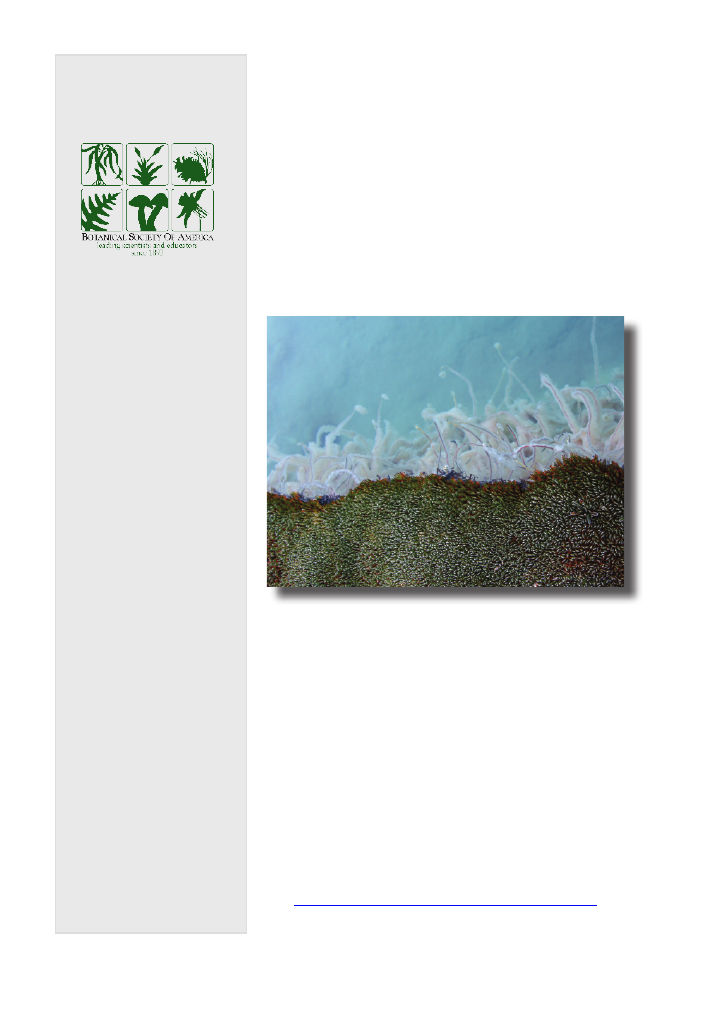
Plant Science Bulletin
Featured Image
Spring 2011 Volume 57 Number 1
Plant Science
Bulletin
ISSN 0032-0919
Published quarterly by
Botanical Society of America,
Inc.
4475 Castleman Avenue
St. Louis, MO 63166-0299
The yearly subscription
rate of $15 is included in the
membership
Send address changes to:
Botanical Society of America
Business Office
P.O. Box 299
St. Louis, MO 63166-0299
bsa-manager@botany.org
Address Editorial Matters (only)
to:
Marshall D. Sundberg
Editor
The Botanical Society of
America is a membership
society whose mission is to:
promote botany, the field of
basic science dealing with the
study and inquiry into the
form, function, development,
diversity, reproduction,
evolution, and uses of plants
and their interactions within the
biosphere
A crystal pond surrounded by cushion plants (Distichia muscoides
Nees & Meyen) provides the playground for Nature to play with
shapes and colors beyond the imagination.
This pond was found at 14,500 ft of elevation, in a deep valley
surrounded by snowy peaks of more than 16,500 ft. The acid
sulfate-chloride thermal water gives rise to the accumulation
of white and yellow mineral crystals on the bottom of the pond
and covering the roots of a colony of Distichia muscoides. The
extremely imbricated leaves of these plants are adapted to the
constant freezing temperatures. The ice of the dawn is still covering
the tips of the leaves.
Nature Games
Mauricio Diazgranados
Saint Louis University
Visit this and all the current
Conant Student Travel Award Submissions at:
http://botany.org/awards_grants/detail/conant.php
